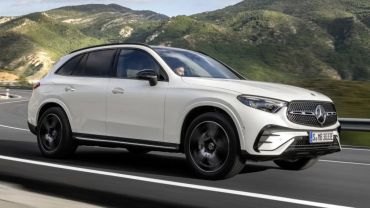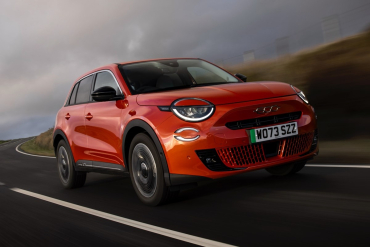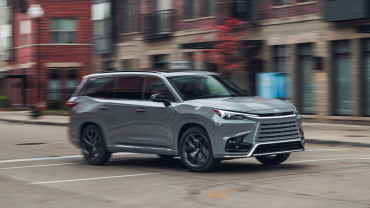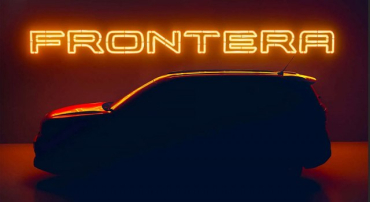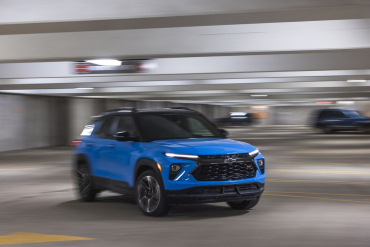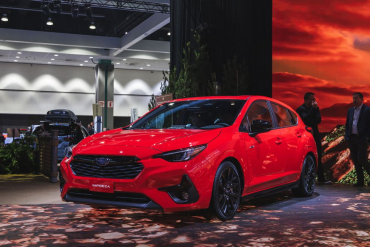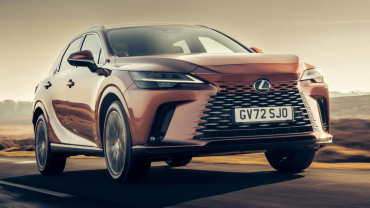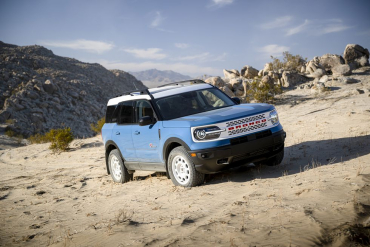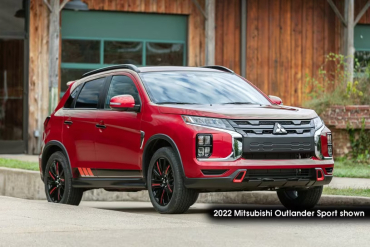Displaying items by tag: SUV
2025 Mercedes-Benz GLC-Class gains PHEV model
Joining the recently redesigned regular Mercedes-Benz GLC-Class and its fastback counterpart will soon be a plug-in hybrid variant. The powertrain option has been absent since the compact luxury SUV was redesigned. Called the 2025 GLC 350e (like its predecessor), the new hybrid offers similar power, but likely much improved range.
The basics sound pretty familiar, with the GLC 350e combining a turbocharged 2.0-liter four-cylinder and an electric motor, with the latter making 134 horsepower and 325 pound-feet of torque on its own. Combined output is also similar at 313 horsepower (down just 2 from before), but significantly less combined torque at 406 pound-feet (from 516). That its 0-60 mph time is now 6.6 seconds rather than 5.6 may be related to that change. All-wheel drive is standard.
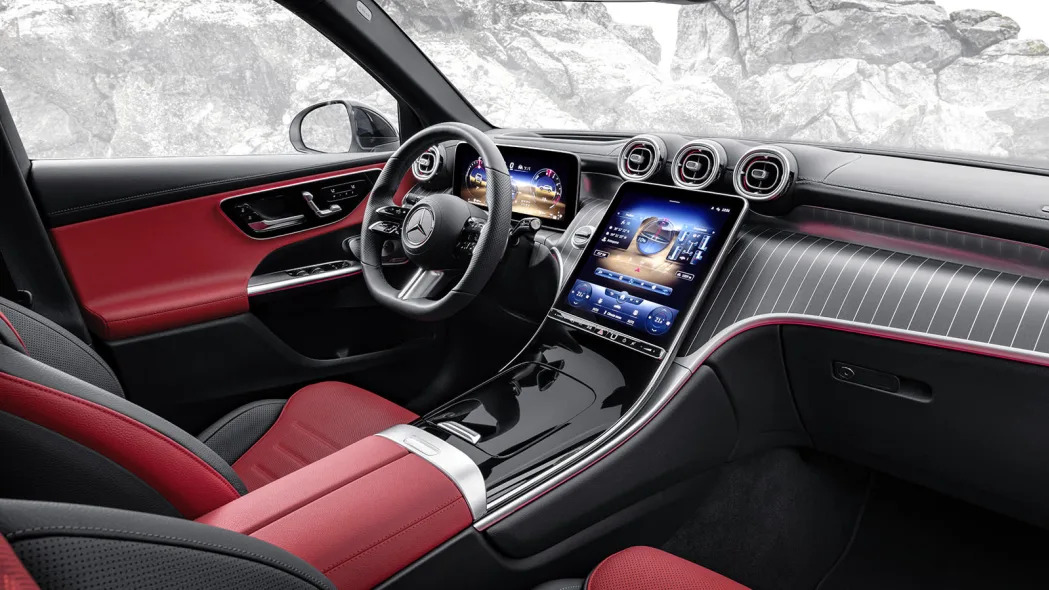
While not as quick, the new PHEV should go much farther on a charge thanks to its 24.8-kWh battery pack. That's 11.3 kWh more than the old battery, nearly doubling its capacity. On the WLTP loop (as U.S. EPA range and fuel economy haven't been announced), the GLC 350e has a seriously impressive range of 81 miles on electricity alone. That will likely be reduced on the EPA test cycle, but will undoubtedly be an improvement over the old model's 22 miles. Somewhere around 40 miles seems like a reasonable expectation. In addition to the added range, AC charging speeds have increased from 7.4 kW to 11, and now the GLC supports DC fast charging up to 60 kW.
The GLC 350e will be offered in three versions, the standard trim, Exclusive and Pinnacle. The standard features list is fairly extensive including a 12.3-inch instrument screen, 11.9-inch infotainment screen, navigation, wireless Apple CarPlay and Android Auto, wireless phone charging, heated seats, dual-zone automatic climate control, ambient lighting, parking sensors and power hatch. On the safety front it has automatic emergency braking, blind-spot warning and automatic lights.
The GLC 350e goes on sale in the second half of this year. Pricing will be announced closer to its on-sale date. It will certainly be priced above the roughly $50,000 of the base GLC 300 4MATIC.
Fiat 600e review - What’s it like inside? What’s it like to drive? Range, charging and efficiency.
Pros & cons
PROS
Proven Stellantis running gear
Attractive pricing
Comfortable ride
CONS
Rear legroom is tight
Boot space isn’t fantastic
Steering is overly assisted
Fiat 600e Overview
Although the electric car market is already rammed full of SUVs, the Fiat 600e adds another contender to the list. It’s a dinky thing, although it should be just about big enough for family duties, with a hybrid version on the way for usefully less money.
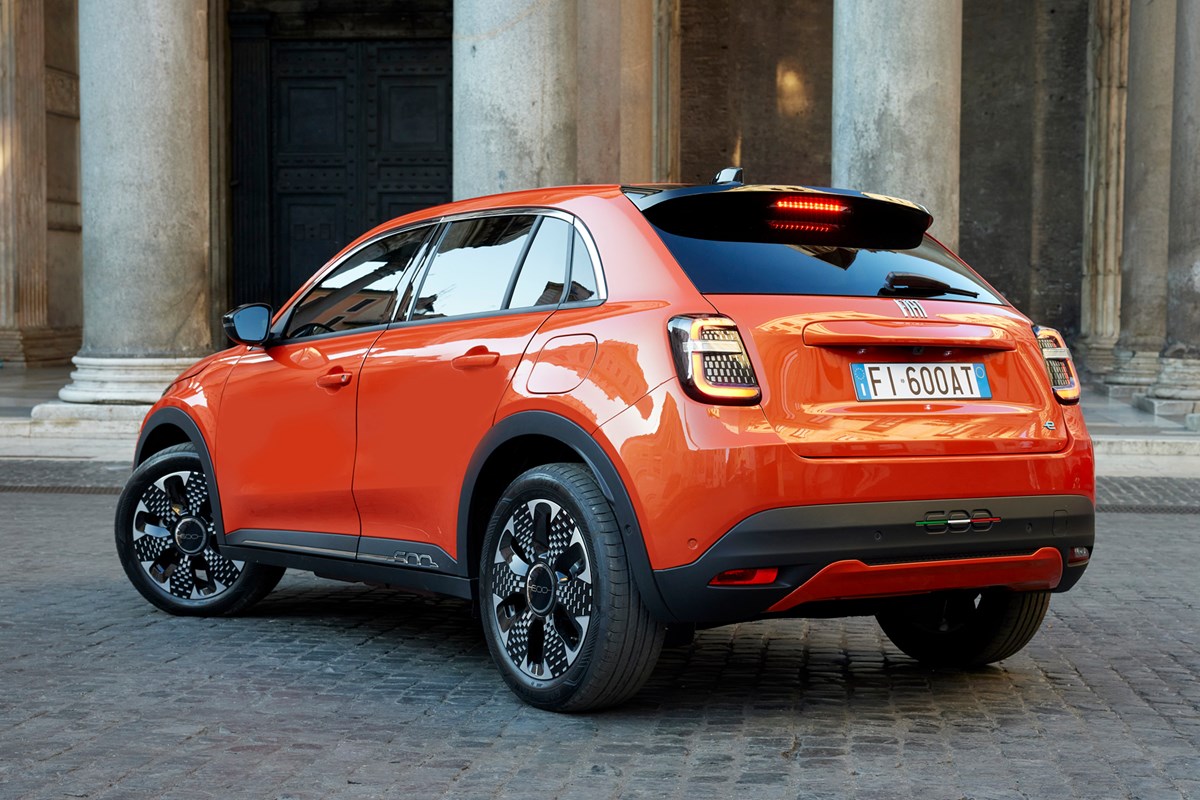
Fiat’s plan for the 600e was to take the appeal of Fiat 500e city car and upscale it to a more practical package. The firm made its task as easy as possible by pinching the 600e’s platform, motor, battery pack and interior technology from the Stellantis parts bin. As such, it has much in common with the new Jeep Avenger, not to mention the DS 3, Peugeot e-2008 and Vauxhall Mokka,
Using existing components isn’t such a bad thing, though. Competition in the compact electric SUV segment is fierce right now – and that means buyers simply aren’t prepared to tolerate poor quality or iffy reliability. The trouble is that the components Fiat used to build the 600e have, until this point, only delivered average results. None of the Stellantis electric SUVs are particularly inspiring to drive and they all offer decidedly average range figures, which means this little Fiat has its work cut out if it’s aiming for the top of the class.
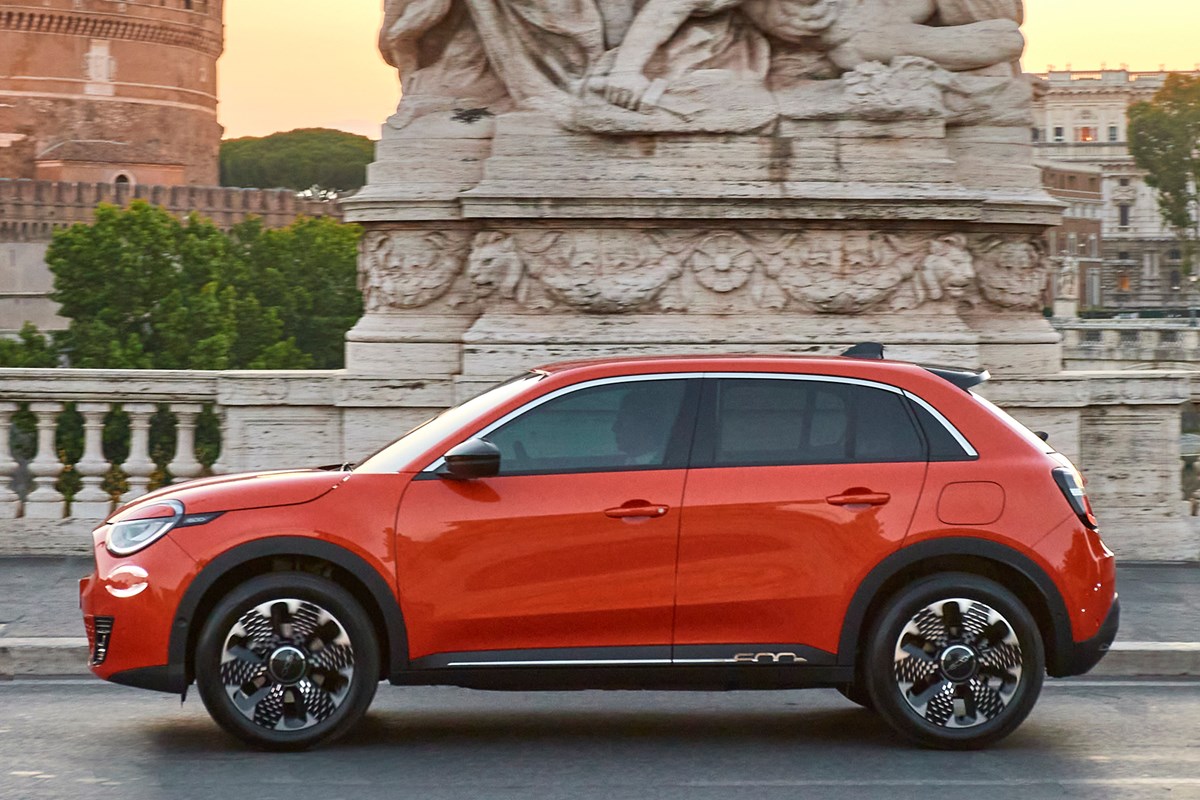
What’s more worrying for Fiat is that, if the 600e doesn’t deliver, drivers will simply shop for one of its many rivals. Key competitors include the Kia Niro EV, the new Hyundai Kona Electric and the equally funky Smart #1. At least the 600e has price on its side, undercutting most rivals even before you’ve factored in a chunky grant from Fiat.
What’s it like inside?
It’s a lot like the Jeep Avenger. The 600e’s centre console, 10.25-inch infotainment system and digital gauge cluster are all identical to the Jeep’s. Fiat has tried to distance its car from its closest sibling, though, by fitting it with a daintier dashboard panel and a curvier instrument binnacle, both of which it says are nods to the original Fiat 500.
It’s certainly an attractive setup, especially when teamed with the cream upholstery offered on the range-topping La Prima model. Practicality is hit and miss but, to be fair to Fiat, we’ll start with the good bits.
Fiat says the 600e’s various cubbies and door bins amount to an extra 15 litres of storage space, which means it should be easy to keep the cabin looking tidy. We’re especially fond of the storage bin between the two front seats. That iPad-style magnetic flap hides a cubby large enough to lose your arm in – and it even features a wireless smartphone charger. There’s plenty of room for people, too, with good headroom and a driver’s seat that goes a long way back.
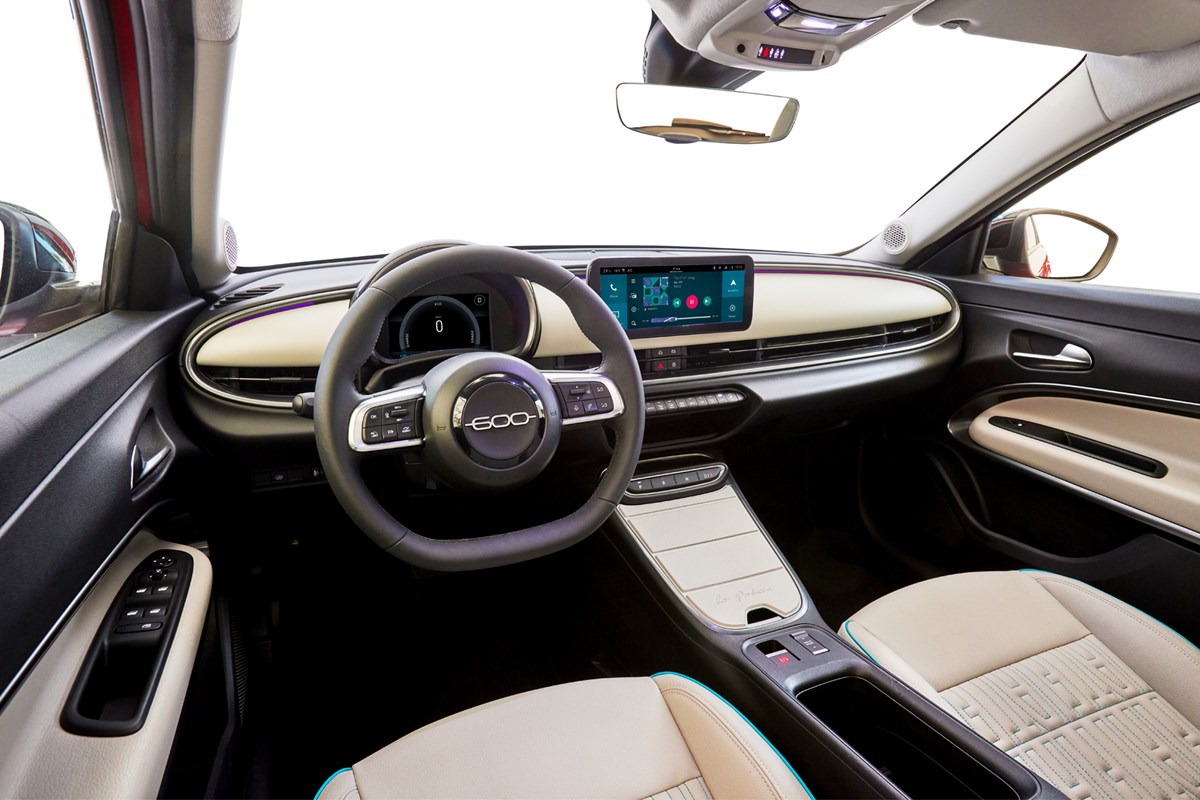
Space in the back is less impressive. If you’re a tall passenger behind even an average-height driver, your knees will press far enough into the front backrest to function as their lumbar support. It’s fine for kids and short families, but we’d point you towards the Smart #1 if rear space is important.
Boot space isn’t fantastic, either. At 360 litres, its a whopping 115 litres smaller than the Kia Niro EV and 110 litres smaller than the bargain-basement MG ZS EV. However, if you fold the rear seats flat, the Fiat 600e’s boot space expands to a perfectly respectable 1,231 litres.
Quality is reasonable overall, although you can see where Fiat has cut some corners. The dashboard and centre console storage tray lid feel high quality, but the plastic used on the centre console and door cards feels like it was pulled from a supermini. This is to be expected given then (relatively) affordable price.
Fiat has also very obviously raided the Peugeot/Citroen parts bin for switchgear – and it hasn’t done a convincing job of integrating the parts into the 600e’s cabin. The drive mode and electronic parking brake switches on the centre console, for example, look like complete afterthoughts.
What’s it like to drive?
Again, it’s a lot like the Jeep Avenger only softer. But that’s to be expected given the mechanical similarities between the two cars. The 600e’s wheelbase (the distance between the front and rear axles) is identical to the Avenger’s, and the suspension is identical save for some slightly different tuning.

Despite this, the 600e is noticeably softer than the Avenger which we think is a good thing. While you certainly hear the suspension working away, it does a good job of smoothing off ruts and bumps. You do feel it bobble around a little on broken surfaces, yet it never feels floaty or uncontrolled. At this price point, it’s one of the comfier small SUVs out there.
It’s reasonably refined, too. Wind noise is kept in check well (thanks in part to the car’s aerodynamic egg-shaped body) and road noise isn’t too intrusive. Wide expansion joins and deep craters will send a judder through the cabin, but the impact felt through your backside is less severe than you get in an Avenger. Or a Cupra Born, for that matter.
There is a trade-off for this comfort, though. Body roll. The 600e really leans over in the corners if you attack them enthusiastically. Push it into a corner especially hard and the stability control system will come down on you like a tonne of bricks, snatching at the brakes to extinguish your fun. While no small electric SUV is a laugh-a-minute, the Smart #3 feels that bit keener.
The steering really doesn’t inspire confidence. There’s very little feedback and its weight doesn’t build in line with your speed which can make it tricky to judge how much lock to apply when cornering on faster roads. You do key into it eventually, while Sport mode adds a little weight if no more feedback.
At least the electric motor is a proven unit. It’s the same 156hp electric motor found in the Jeep Avenger and the updated Vauxhall Corsa Electric – and it’s perfectly adequate. Fiat says it allows the 600e to sprint from 0–62mph in nine seconds flat before reaching a top speed of 93mph.
Rivals such as the Kia Niro EV and Hyundai Kona Electric are noticeably faster in a straight line. The fastest Kona, for example, has 218hp and it can get from 0–62mph in 7.8 seconds, so it feels much spryer. Still, the 600e has more than enough poke to carve up your average petrol-powered hatch at the lights.
Like most EVs, Performance tails off as you build speed, but it has just enough power left in the tank to consider an overtake approaching the national speed limit. You can also control the response and performance of the electric motor by cycling through the car’s drive modes. The motor’s maximum output is limited in Eco and Normal modes to conserve battery power – but in Sport mode you get the full 156hp.
Thankfully, and unlike some EVs, you can access all 156hp in any mode by planting your foot flat to the floor, pushing down past the kickdown switch. That’s handy if you’ve got an eye on range but suddenly need an additional uplift in performance.
Range, charging and efficiency
The 600e is based on the same e-CMP2 architecture found under most Stellantis small electric cars, but it’s powered by the company’s new 54kWh battery pack. The Italians reckon that’s enough to give the 600e a maximum range of 250 miles with a mixture of motorway and city driving, or up to 375 miles if you’re just dithering around town.
37Fiat 600e charging socket, orange paintThe top-spec La Prima model gets 100kW DC rapid charging.
Like its siblings, the 600e will struggle to achieve its maximum range in the real world. We couldn’t get anywhere near the 5.0 miles per kWh efficiency you’d need to hit 250 miles, with the real range sitting around the 200 mile mark.
There’s one crumb of comfort, though. The 600e charges much more quickly than the older Stellantis EVs based on the previous version of the e-CMP architecture thanks to 100kW DC rapid charging. As such, its battery can charge from 20 to 80% capacity in less than half an hour. Slower 11kW AC charging is also supported – and that can fully recharge the car’s cells in around six hours.
What else should I know?
Fiat has decided it won’t sell the 600e (or any of its new cars for that matter) with grey paint. That’s a bold move, especially when you consider that grey is currently the most popular colour for new cars in the UK. But Fiat reckons UK buyers are wrong and the colour grey is boring. From now on, it’ll only allow its customers to choose from a range of bright colours. You can read more about Fiat’s new paint palette on our sister site, CAR magazine.
37Fiat 600e infotainmentInfotainment is reasonably easy to navigate, but not the snappiest to respond.
There are just two specifications to choose from. The most basic (RED) model is priced from £32,995 which, most importantly, undercuts the cheapest Jeep Avenger by around £2,700. The (RED) specification continues Fiat’s long-lived partnership with the international charity of the same name. It comes with a reasonable amount of standard equipment, including LED headlights, rear parking sensors, keyless go, cruise control and traffic sign recognition. You also get the 7.0-inch digital instrument cluster and 10.25-inch infotainment system with wireless Apple CarPlay and Android Auto. But it still has steel wheels, strangely.
The flagship La Prima model is a bit pricier at £36,995. You do get a lot more equipment for your money, though. Upgrades includes an electrically adjustable and massaging driver’s seat, a wireless smartphone charger, a rear-view camera and cream leather upholstery (with a rather natty embroidered Fiat motif). Both front seats also have heating elements and there are a few more charging ports dotted around the cabin. Most importantly, the upgrade unlocks 100kW DC charging.
Crucially, Fiat are promising to continue their £3,000 ‘e-grant’ all the way through 2024. When you factor in a starting price of of less than £30k, the 600e suddenly becomes a lot more tempting. Click through to our verdict page to learn whether the Fiat 600e is worth waiting for, or whether you should opt for one of its rivals instead.
Fiat 600e verdict
Should you buy one?
The Fiat 600e is a difficult car to recommend because it doesn’t deliver on its goals as an electric family car. The rear seats are just too cramped and there are plenty of rivals on the market that offer more space in the boot and longer electric ranges, such as the Hyundai Kona Electric.
Despite this, we think the Fiat 600e is the best small electric SUV Stellantis has built so far. It’s the only one that rides properly and, with its bright paint finishes, cutesy smiling face and quirky cabin, it’s genuinely desirable. You’ll certainly stand out from the crowd – and its starting price of £32,995 before discounts looks rather enticing alongside the £37,295 you’ll spend on the most basic Kia Niro EV or the £35,950 required for the entry-level Smart #1.
But there’s a caveat to our praise. The 600e is the high watermark in a crashing sea of mediocrity from Stellantis. If you look outside the group, you’ll find plenty of objectively better small electric SUVs that we think you should consider first, such as those mentioned above. So, while the Kia and the Smart might be more expensive, the former offers more space inside while the latter is much more fun to drive.
What we like
A comfortable ride is welcome on Britain’s battered roads, and equipment levels are good. It’s also more affordable than most of its rivals.
What we don’t like
The real world range isn’t great, the rear seats cramped, and the boot is smaller than most rivals’.
Source: parkers.co.uk
Tested: 2024 Lexus TX500h Offers Large-Family Largesse
The TX is Lexus's most family-friendly three-row to date.
Lexus's history with three-row SUVs is not especially heroic. The body-on-frame GX and LX have space but ride like trucks. The now-dead RX L drove better, but its diminutive third row had Porsche 911 levels of comfort. Lexus needed a better solution. Enter the 2024 Lexus TX. Sharing a platform with Toyota's Grand Highlander, it scratches the family-truckster itch better than any of its predecessors.
The TX comes in three flavors of powertrain. Sitting between the 275-hp turbo 2.4-liter and the 404-hp plug-in hybrid, the TX500h features an electric motor, a turbocharged 2.4-liter four, a six-speed automatic, and another motor that motivates the rear axle to provide all-wheel drive. The powertrain is good for 366 horsepower and 406 pound-feet of torque. It parallels Toyota's Hybrid Max setup but nudges output up by four horsepower and six pound-feet.
The extra power helps shore up the 5119-pound TX500h's performance versus the 183-pound-lighter Grand Highlander Hybrid Max. The TX's 5.7-second 60-mph time and 14.5-second quarter-mile both are just fractionally behind the Grand Highlander's. And despite the TX500h wearing the F Sport badge, the adaptive dampers err toward softness, providing a much cushier ride. Lexus also fits larger 15.7-inch front brakes, and the TX's 174-foot stopping distance from 70 mph handily beats its sibling's 187-foot result. The Lexus's 0.85-g skidpad grip also eclipses the Toyota's 0.80-g effort.
HIGHS: Supple in all the right ways, fuel-miser powertrain, space to spare.
LOWS: Steep pricing, some silly interior ergonomics, angry face.
VERDICT: Finally, a three-row SUV worthy of the Lexus badge.
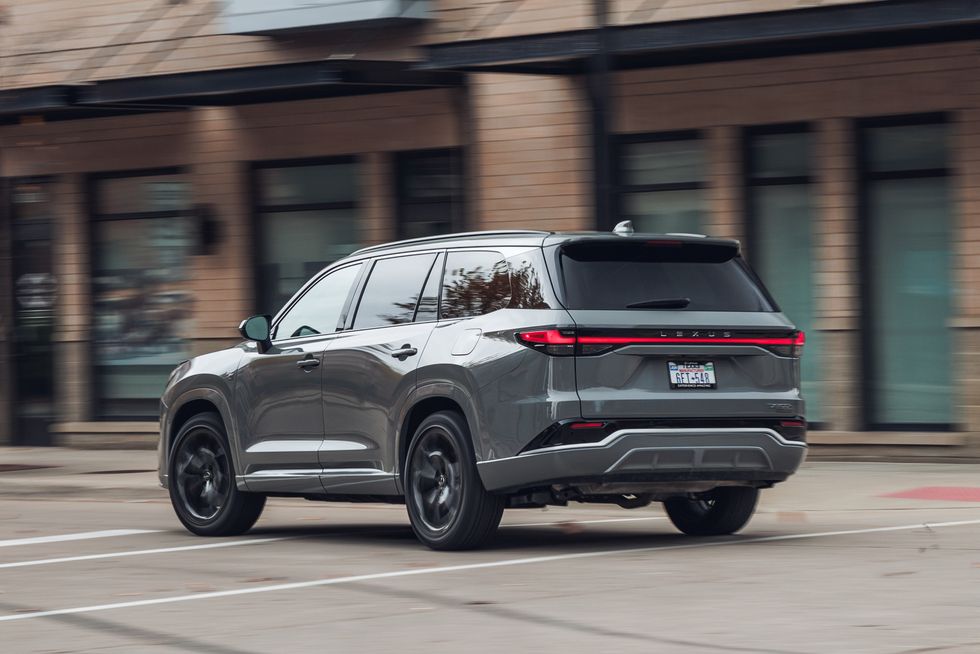
On our highway test, the TX achieved 26 mpg, 2 mpg below the EPA estimate but 2 mpg better than the Grand Highlander's result.
The softly lined cabin's high points include USB-C ports in all rows, the center console's sliding wireless charger and swappable cupholders, and a third row that can fit two actual adults. It's not perfect, though. Electronic door handles still feel strange to us, and we wish the temperature dials had detents for easier no-look adjustments. If only the cabin's demure design were shared by the front fascia, which looks like an angry cheese grater.
At $77,159 as tested, the TX500h is also priced aggressively. But you'd be hard-pressed to find a three-row utility vehicle that treats its occupants as well as this Lexus.
What's in a Name?
Did Lexus name its new three-row SUV after the Lone Star State it calls home? No, but no one minds if you think so. "The 'Lexus Texas' thing was a wordplay we couldn't pass up," a Toyota spokesperson told us, even if the actual origin is "a bit more vanilla." TX stands for "Thoughtful/Three-Row X-Over." A little less vanilla is the similarity to the name of actress Alexis Texas.
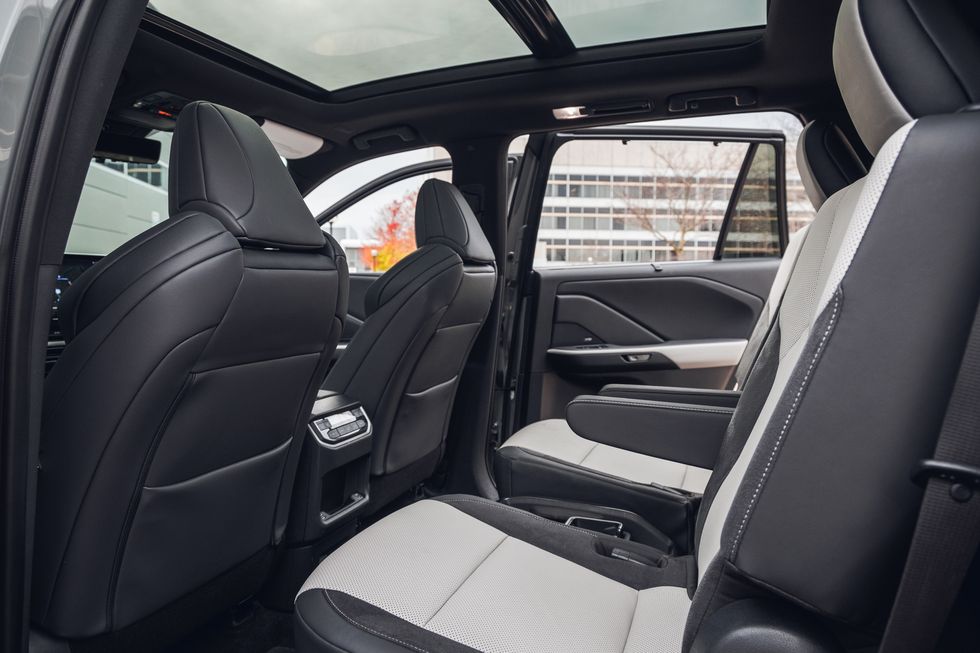
Specifications
2024 Lexus TX500h F Sport Performance Luxury AWD
Vehicle Type: front-engine, front- and rear-motor, all-wheel-drive, 6-passenger, 4-door wagon
PRICE
Base/As Tested: $72,650/$77,159
Options: Technology package (peripheral monitor camera, head-up display, remote park assist, digital rearview mirror, interior rearview mirror, garage door opener), $2380; Convenience package (pre-collision system, lane-keeping assist, rear and rear side monitor, digital entry key), $895; 120V/1500-watt power outlet, $560; rear hatch cargo lamps, $399; side puddle lamps, $175; Cold Area package (wiper/window/windshield deicer), $100
POWERTRAIN
turbocharged and intercooled DOHC 16-valve 2.4-liter inline-4, 271 hp, 339 lb-ft + 2 AC motors, 85 and 101 hp, 215 and 124 lb-ft (combined output: 366 hp, 406 lb-ft; 1.4-kWh nickel-metal hydride battery pack)
Transmissions: 6-speed automatic/direct-drive
CHASSIS
Suspension, F/R: struts/multilink
Brakes, F/R: 15.7-in vented disc/13.3-in vented disc
Tires: Continental CrossContact LX20
255/45R-22 107V M+S Extra Load
DIMENSIONS
Wheelbase: 116.1 in
Length: 203.5 in
Width: 78.4 in
Height: 70.1 in
Passenger Volume, F/M/R: 60/54/39 ft3
Cargo Volume, Behind F/M/R: 97/57/20 ft3
Curb Weight: 5119 lb
C/D TEST RESULTS
60 mph: 5.7 sec
1/4-Mile: 14.5 sec @ 95 mph
100 mph: 16.2 sec
Results above omit 1-ft rollout of 0.4 sec.
Rolling Start, 5–60 mph: 6.3 sec
Top Gear, 30–50 mph: 2.7 sec
Top Gear, 50–70 mph: 4.0 sec
Top Speed (gov ltd): 116 mph
Braking, 70–0 mph: 174 ft
Roadholding, 300-ft Skidpad: 0.85 g
C/D FUEL ECONOMY
Observed: 23 mpg
75-mph Highway Driving: 26 mpg
75-mph Highway Range: 440 mi
EPA FUEL ECONOMY
Combined/City/Highway: 27/27/28 mpg
Source: caranddriver.com
Opel is reviving the Frontera
The new Frontera will feature a spacious cabin, which should attract customers looking for a compact family vehicle.
The name Frontera is already familiar to car enthusiasts and fans of the Opel brand. The off-road vehicle based on the Isuzu MU gained great popularity in the 1990s, primarily due to its off-road capabilities.
Opel has now announced the return of the Frontera name, or rather the model that they will introduce to the market this year. The German manufacturer states that it will be an SUV that will be available with electric drive from the start of sales.
The Opel Frontera will have plenty of space in the cabin, which should attract customers looking for a compact family vehicle. In addition to electric versions, petrol engines and plug-in hybrids are also expected.
The question arises: which segment will the Frontera belong to? Given that Opel is launching the successor to the compact SUV Grandland this year, some media speculate that the Frontera will be an extended version of that vehicle. Similarly, the sister brand Peugeot does the same with the 3008 and 5008 models.
On the other hand, there are speculations that the new Frontera is the successor to the current Crossland model.
In any case, you can forget about the former Frontera with a classic steel chassis carrying a body with an engine. The new model will be a family SUV with a monocoque body, which will also have numerous functionalities, just a slightly different structure.
Tested: 2024 Chevy Trailblazer Is Outshined by Its Smaller Sibling
A refresh can't save Chevrolet's subcompact SUV from being upstaged by the Trax, which is both more affordable and more appealing.
It's embarrassing to be upstaged by a little sibling. Just ask the Chevrolet Trailblazer, a subcompact SUV that's been around since 2021. The underachieving Trax sitting next to it in the showroom never really gave the Trailblazer cause for concern, until the redesigned 2024 Trax showed up with a whole new outlook on life. The new Trax promises more space, appealing style, and new features—all for significantly less money—and we just awarded it a 10Best Trucks and SUVs trophy. It is already encroaching on the Trailblazer's sales numbers, too, outselling it in the third quarter of 2023.
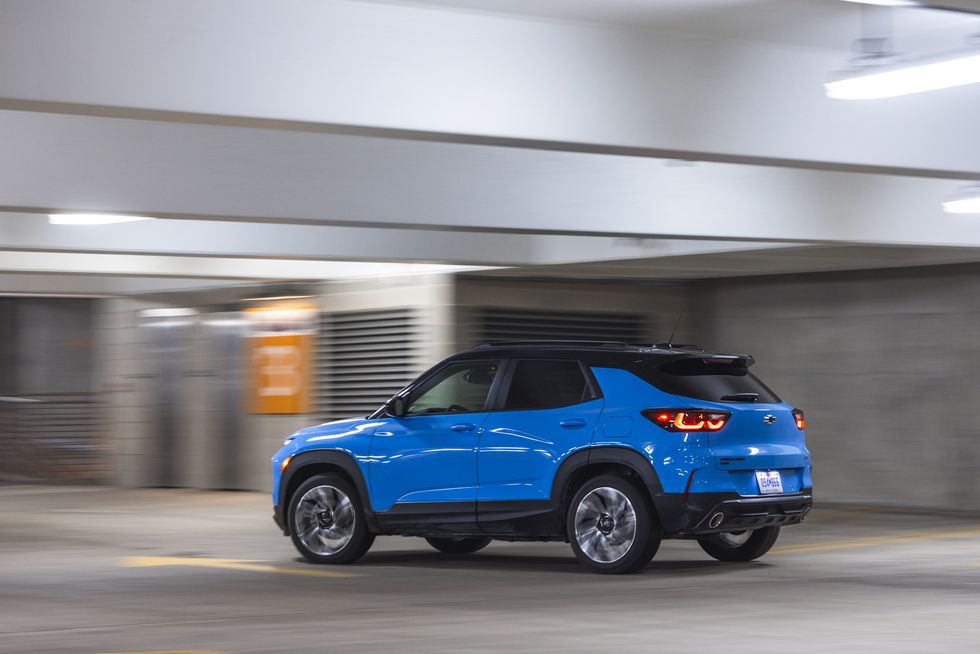
HIGHS: Cheeky looks, refined ride, strong brakes.
The Trailblazer is doing its best to stay relevant, and a refresh for the 2024 model year brings bigger screens inside, freshened looks, and new colors. But the Trailblazer is facing an uphill battle against its significantly cheaper stablemate—and against other vehicles in this competitive segment.
One might wonder why Chevrolet bothers to sell both the Trax and the Trailblazer. These two models are an example of a split that's evident within the subcompact-crossover segment. The Trax is meant to compete with the smaller, front-wheel-drive-only pseudo-hatchbacks that exist on the lower end of the price spectrum—think Kia Soul, Hyundai Venue, and Nissan Kicks—while the taller Trailblazer is meant to be a "real" SUV (in that it offers optional all-wheel drive, at least) that costs a bit more and has a more upright shape.
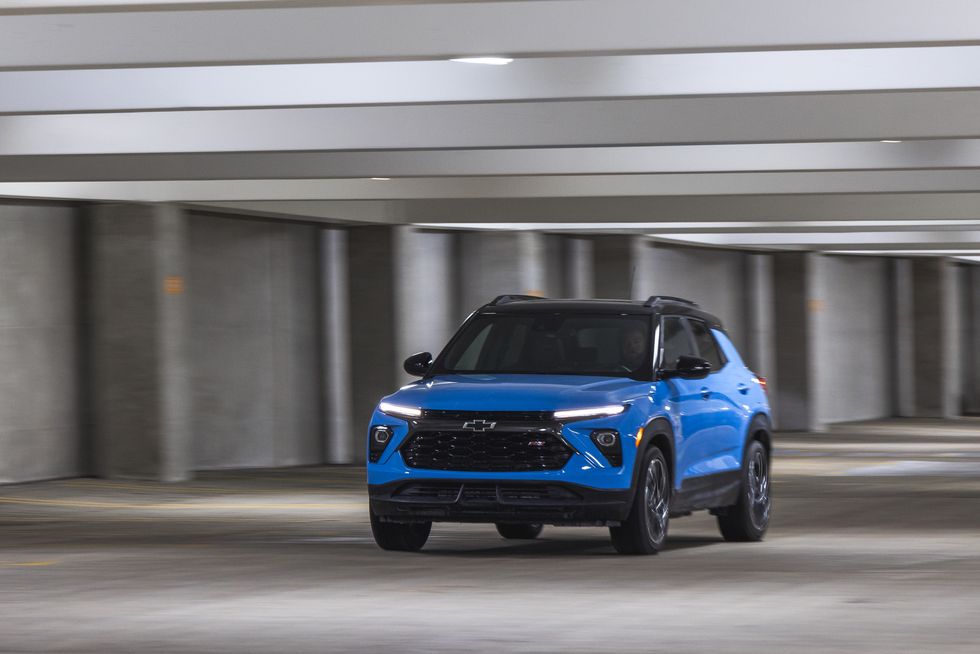
LOWS: Sluggish acceleration, cheap interior materials, questionable value.
It's not entirely an illusion, either, as the Trailblazer has a higher seating position than the Trax by more than two inches, according to our measurements. And, if you select all-wheel drive, the Trailblazer does offer a more compelling optional powertrain, a 155-hp 1.3-liter turbocharged three-cylinder with a nine-speed automatic transmission (as opposed to a CVT in other Trailblazers and a six-speed automatic in the Trax). There is a bit more refinement to be found in the Trailblazer, too, as its heavier curb weight creates more of a planted feeling on the road. We like the way the Trailblazer steers, and its brake pedal exhibits good feel, bringing the SUV to a rest from 70 mph in just 166 feet.
But when you look more closely at the numbers, paying more for the Trailblazer starts to make less and less sense. The Trax's longer wheelbase means it offers slightly more passenger room, and it even has a bit more cargo room with the seats folded, swallowing 21 carry-on suitcases in our testing compared with the Trailblazer's 19. Plus, the Trax's 1.2-liter engine is barely at a disadvantage next to the heavier Trailblazer's 1.3-liter. The Trax gets to 60 mph just 0.1 second slower and had a slightly better performance in our real-world 75-mph highway fuel-economy test (30 mpg, versus 29 mpg for the Trailblazer).
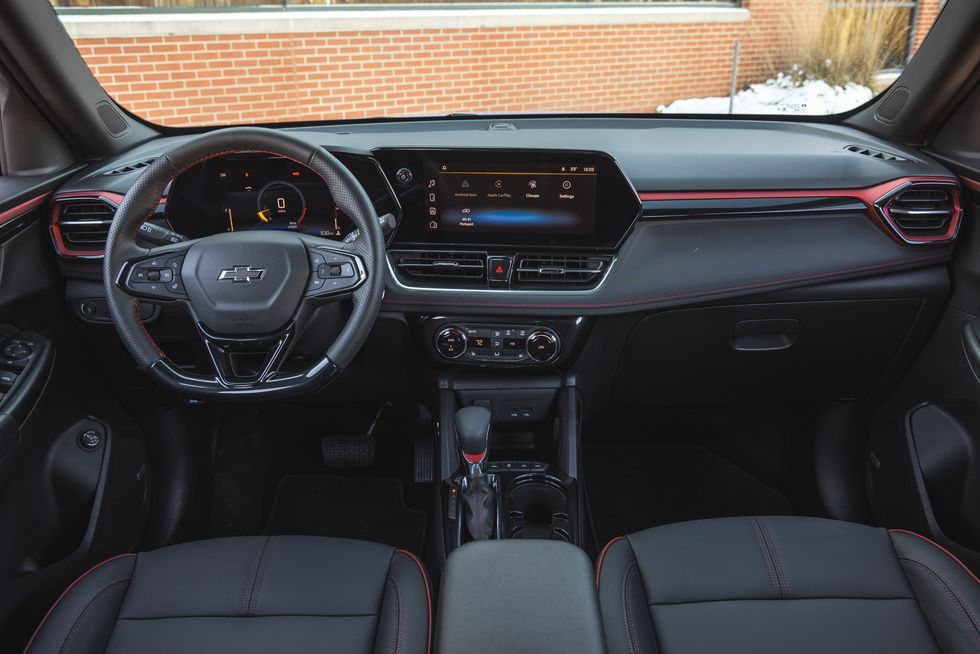
The price difference is what really makes the fight seem unfair. The Trax's base price sits at just $21,495, while a comparable Trailblazer is nearly $3000 dearer. The disparity grows when you start piling on options, as our loaded Trailblazer RS AWD—admittedly thick with desirable extras such as a panoramic sunroof and a power liftgate, neither of which the Trax offers—stickered for $34,470. A loaded Trax, on the other hand, barely crests $27,000.
VERDICT: The Trailblazer suffers from the existence of the more compelling Trax.
If you're merely looking to spend as little money as you can on a satisfying crossover-esque small car, the high-value Trax is a no-brainer. But if you're willing to shell out more for things like all-wheel drive and interior niceties, several more attractive options exist within the Trailblazer's price range, including the Mazda CX-30 and the Kia Seltos. That leaves the Trailblazer stuck in an awkward liminal space, with little to recommend it unless you manage to snag an attractive discount.
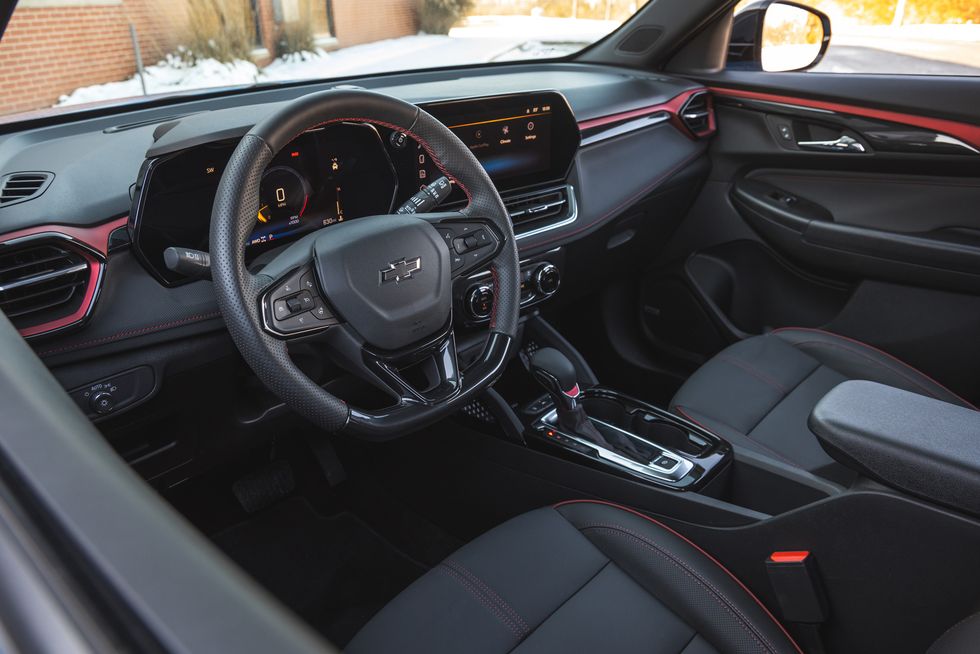
Specifications 2024 Chevrolet Trailblazer RS AWD
Vehicle Type: front-engine, all-wheel-drive, 5-passenger, 4-door wagon
PRICE
Base/As Tested: $29,995/$34,470
Options: power panoramic sunroof, $1495; Convenience package (automatic climate control, rear type-A and -C USB ports, wireless device charging, 120-volt outlet, auto-dimming interior mirror, driver and passenger illuminated vanity mirrors, power liftgate), $1195; Adaptive Cruise and Sound package (7-speaker Bose sound system, adaptive cruise control), $995; Fountain Blue paint, $395; Driver Confidence package (blind-spot monitoring, rear-cross-traffic alert, rear park assist), $395
ENGINE
turbocharged and intercooled DOHC 12-valve inline-3, aluminum block and head, direct fuel injection
Displacement: 82 in3, 1338 cm3
Power: 155 hp @ 5600 rpm
Torque: 174 lb-ft @ 1600 rpm
TRANSMISSION
9-speed automatic
CHASSIS
Suspension, F/R: struts/torsion beam
Brakes, F/R: 11.8-in vented disc/10.4-in disc
Tires: Continental ProContact TX
245/45R-19 98H M+S TPC Spec 3178
DIMENSIONS
Wheelbase: 103.9 in
Length: 173.5 in
Width: 71.2 in
Height: 65.7 in
Passenger Volume, F/R: 50/45 ft3
Cargo Volume, behind F/R: 54/25 ft3
Curb Weight: 3390 lb
C/D TEST RESULTS
60 mph: 8.7 sec
1/4-Mile: 16.7 sec @ 83 mph
100 mph: 28.0 sec
Results above omit 1-ft rollout of 0.3 sec.
Rolling Start, 5–60 mph: 9.5 sec
Top Gear, 30–50 mph: 4.5 sec
Top Gear, 50–70 mph: 6.5 sec
Top Speed (C/D est): 130 mph
Braking, 70–0 mph: 166 ft
C/D FUEL ECONOMY
Observed: 23 mpg
75-mph Highway Driving: 29 mpg
75-mph Highway Range: 380 mi
EPA FUEL ECONOMY
Combined/City/Highway: 27/26/29 mpg
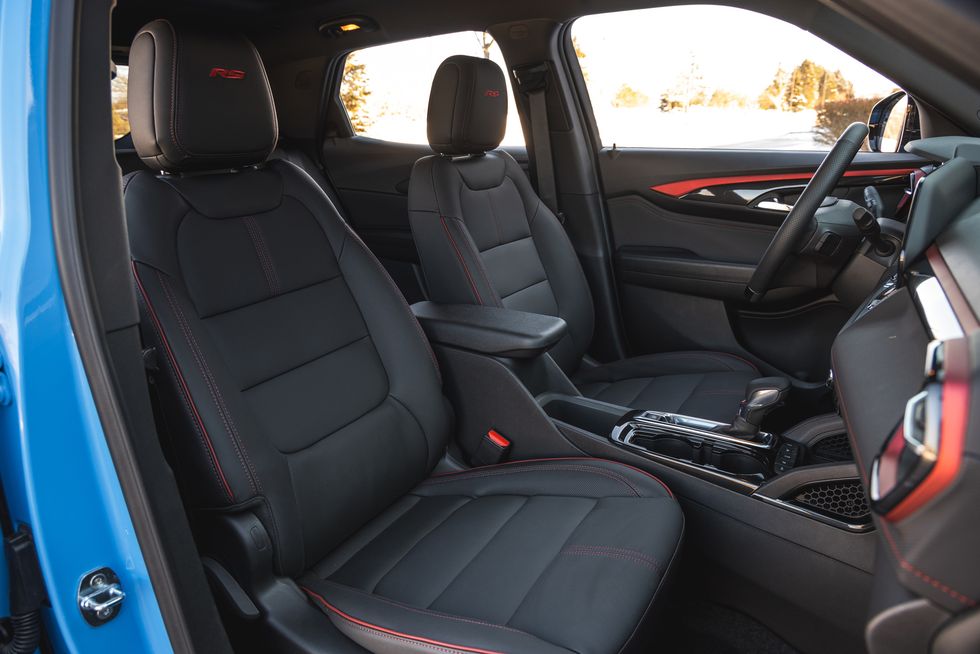
Source: caranddriver.com
2024 Subaru Impreza - First review
Subaru is rolling out the sixth-generation Impreza for the 2024 model year, and with it comes new looks, new technology, and a new powertrain option. The new Subie made its debut at the 2022 Los Angeles Auto Show just as it did when it showed face for the first time in 1992. Like the '90s original, the 2024 Impreza will be once again offered in sporty RS guise, powered by a 182-hp 2.5-liter four-cylinder borrowed from the Crosstrek SUV. Lower-priced and lower-powered base and Sport models get a 152-hp 2.0-liter instead. Subaru says the 2024 Impreza's chassis is stiffer than before and the compact hatchback's all-wheel-drive system now features active torque vectoring. We won't know if any of that adds more spark to the Impreza's personality until we get our hands on one, but for now, we'll say things look promising.
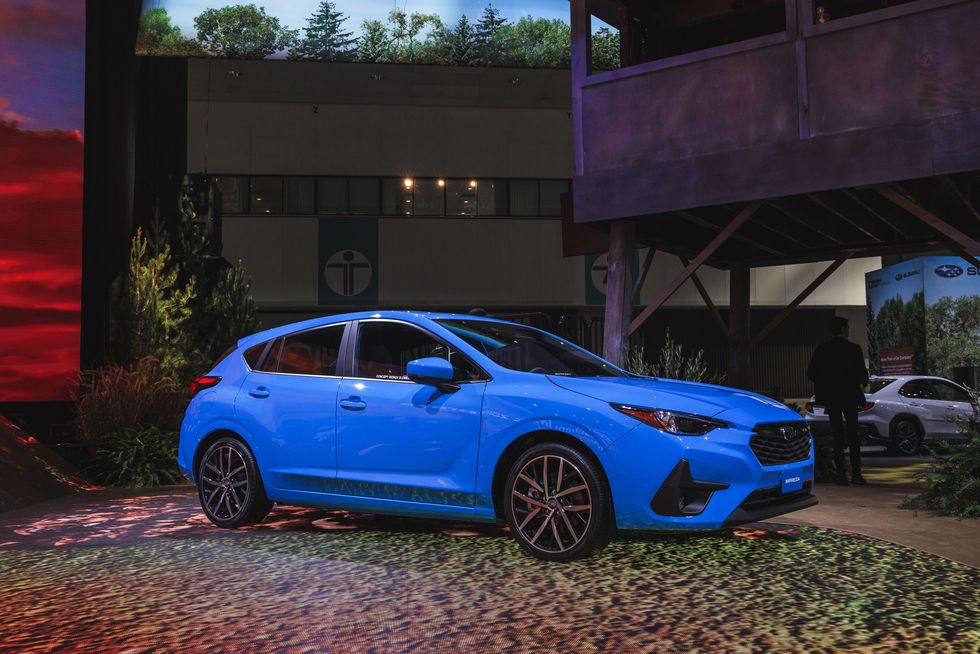
What's New for 2024?
So far, we know about several key changes to the Impreza model line. For starters, Subaru has made the continuously variable automatic (CVT) standard on all 2024 Imprezas. Unfortunately for three-pedal advocates, the automaker hasn't mentioned the availability of a manual transmission. Additionally, the Impreza is slated to be offered exclusively in a five-door hatchback body configuration–something WRX fanatics will surely envy, as they've been hoping for a WRX hatchback since it was discontinued after the 2014 model year. Speaking of the WRX, updates to the Impreza's exterior are similar to the design language seen on the latest generation of both the WRX and Crosstrek. Unlike those two models, though, the next-gen Impreza rolls without any plastic cladding clinging desperately to its body. Changes to the interior design make it almost identical to that of its newer stablemates, particularly the Crosstrek. The 11.6-inch Starlink touch display is available in the Impreza for the first time and is standard on Sport and RS trim levels.
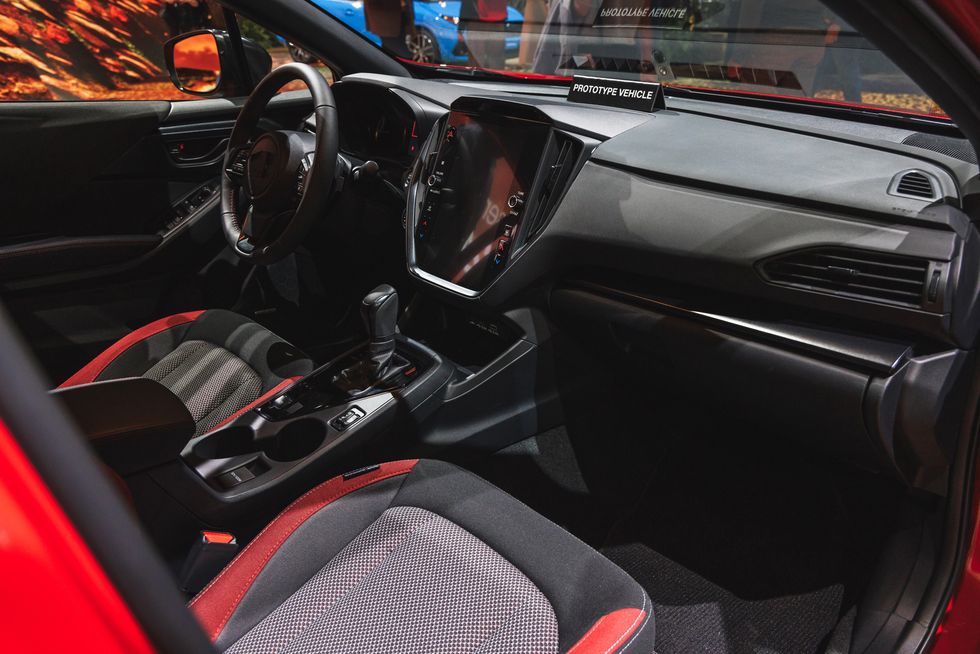
Given our natural disposition towards sports-oriented vehicles, plus the power of nostalgia, we're most interested in the reborn Impreza RS, which comes with a more powerful 2.5-liter four-cylinder engine, unique 18-inch wheels, artificial carbon fiber interior trim, a leather-wrapped steering wheel, aluminum-finished pedals, heated front seats, a 10-way power driver's seat with lumbar support, and USB charge ports for rear passengers.
Engine, Transmission, and Performance
The Impreza retains its meager naturally aspirated 2.0-liter flat-four engine, which musters the same 152 horsepower and 145 pound-feet of torque as before. A larger 2.5-liter four-cylinder boxer engine will be exclusively available for the new RS model, providing a power bump of 30 horsepower and 33 pound-feet of torque for a total output of 182 horses and 178 pound-feet. A CVT is standard on all 2024 Imprezas as is Active Torque Vectoring, which improves upon the capable Subaru Symmetrical All-Wheel Drive system. For an extra sprinkling of its rally racing sportiness, Subaru has equipped the new Impreza with a version of the dual-pinion electronic power steering rack found in the WRX. The automaker says that it has increased the chassis stiffness of the next-gen Impreza by 10 percent, too, which in theory should help both handling and ride. We'll update this section with performance figures once we've driven and tested the all-new Impreza.
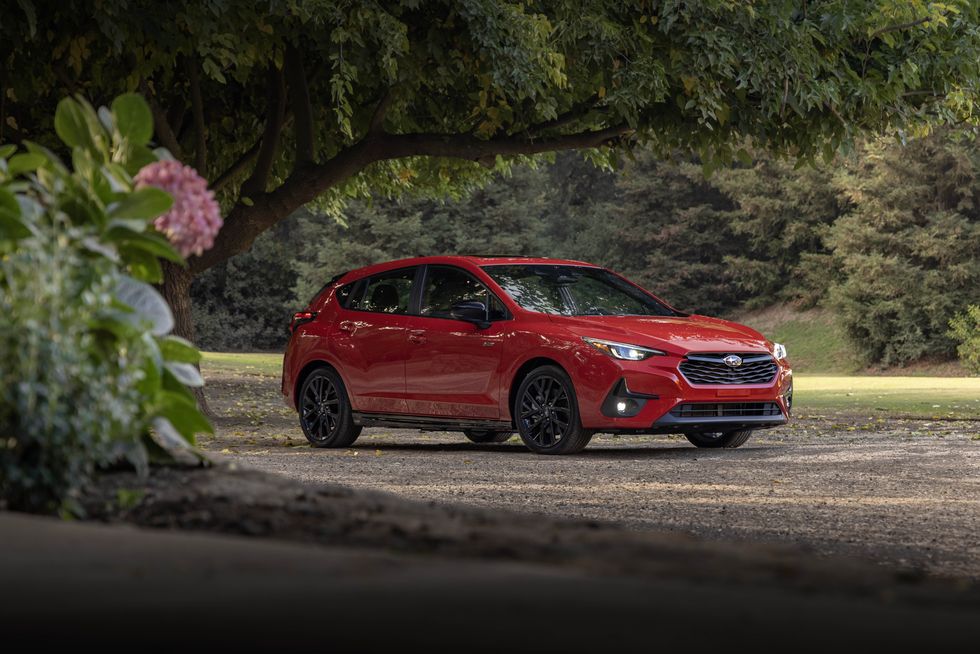
Fuel Economy and Real-World MPG
Since the base Impreza and Impreza Sport models will both make use of the same 2.0-liter engine in the outgoing model, we think it's safe to assume that EPA ratings will be similar to those of the current five-door hatchback equipped with the CVT: 28 miles per gallon in the city and 36 on the highway. We'll update this section once the EPA has published its ratings and after we've run the Impreza through our 75-mph highway fuel economy route which is part of our extensive testing regimen.
Interior, Comfort, and Cargo
Subaru interiors are known for being pragmatic rather than posh, and that trend continues with the 2024 Impreza. Dual-zone climate controls are standard for the entire model line as are 60/40 folding rear seats. The automaker says it focused its efforts on an ergonomic front seat design and also hushing the cabin–we'll verify whether it's more comfortable and quieter than the fifth-gen model once we've had the chance to get behind the wheel. From what we can tell so far, the updates appear to be similar to the changes found inside the 2022 WRX, including a larger center stack display. The revisions in the WRX sports sedan felt and looked like a natural progression from the interior design of the preceding generation, and we expect the same from the new hatchback since their interior designs are nearly identical.
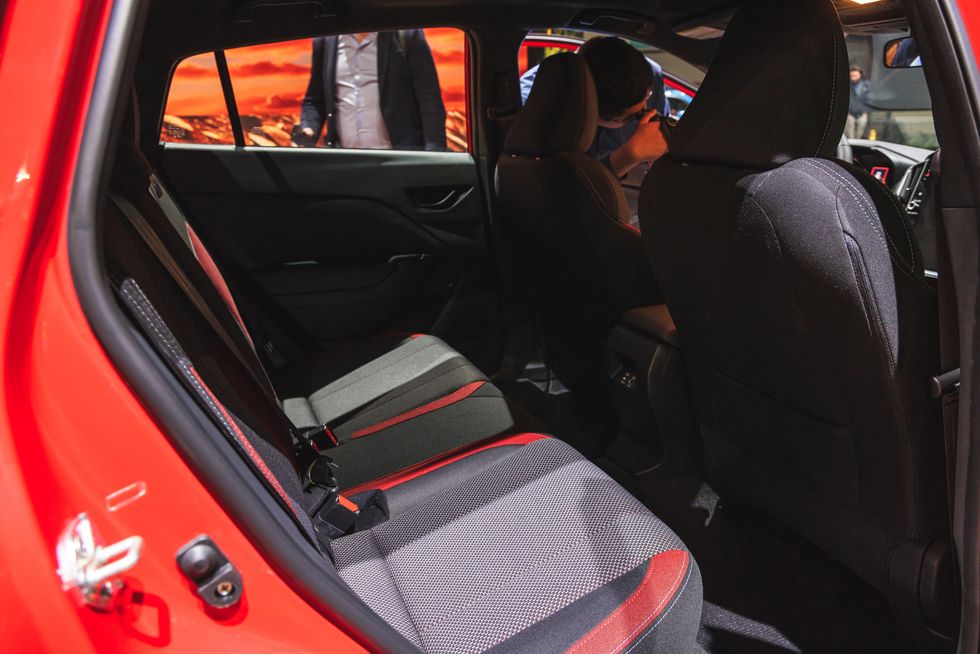
Infotainment and Connectivity
The 2024 Subaru Impreza offers the automaker's Starlink multimedia system standard on Sport and RS models. It is compatible with wireless Apple CarPlay and Android Auto and features an 11.6-inch touchscreen display with controls for the sound system, HVAC, and certain vehicle functions. For models equipped with Starlink, Subaru also offers its Safety and Security Connect Services, such as SOS Emergency Assistance and Stolen Vehicle Recovery Service, as well as conveniences like Remote Vehicle Locator. On top of that, the new Impreza provides its passengers with an auxiliary input jack, a USB-C port, and a USB-A port, so you're set regardless of which smartphone you happen to have. There's also an available Harmon Kardon 10-speaker sound system, though it's only offered on the range-topping RS model.
Safety and Driver-Assistance Features
In addition to the aforementioned Safety and Security Connected Services available for models equipped with Starlink, Subaru has made its EyeSight Driver Assist Technology standard for all three Impreza trim levels. Automatic emergency steering is included on models fitted with the optional blind-spot detection system, which is already packaged with lane-keep assist and rear cross-traffic alert—all of which are standard on the new RS model. Subaru is also introducing a few new services to the 2024 Impreza, including Valet Mode, Trip Log and Driving Journal, and Remote Vehicle Configuration. Neither the National Highway Traffic Safety Administration (NHTSA) nor the Insurance Institute for Highway Safety (IIHS) websites have crash-test results for the next-generation Impreza yet. Key safety features include:
Standard adaptive cruise control and lane-keep assist
Available blind-spot monitoring and rear cross-traffic alert
Available automatic emergency steering
Warranty and Maintenance Coverage
The Impreza's warranty is average for the class and not as generous as that of the Hyundai Elantra or the Kia Forte, both of which offer powertrain coverage for up to 10 years or 100,000 miles.
Limited warranty covers three years or 36,000 miles
Powertrain warranty covers five years or 60,000 miles
No complimentary scheduled maintenance
New Lexus RX 450h+ 2023 review
Lexus's large SUV offers plenty of luxury and tech, but it's not as family-friendly as its size would suggest
Verdict
The new Lexus RX 450h+ delivers on plenty of traditional Lexus attributes. There’s an impressive array of technology on board, the ride is tuned for comfort above all else and the build quality is exemplary. It’s a big SUV so fairly average practicality might be its undoing for some families and keen drivers will be better served elsewhere.
The Lexus RX was one of the first to secure a slice of the burgeoning luxury SUV sector when it launched in the late 1990s and the model line has gone on to reach 3.5million sales globally, helped by its pioneering hybrid technology.

Within the Lexus stable, the RX has been arguably the most successful car at taking on the established players from Germany. The incorporation of a self-charging hybrid powertrain in 2005 was a defining moment for the RX, but since then it’s taken evolutionary steps with a clear focus maintained on comfort and build quality. With this fifth-generation RX, however, Lexus claims it has made “a complete reinvention of the large luxury SUV” and produced a large premium SUV that is more competitive than ever.
The new RX has arrived just at the right time. 2023 has seen both the Mercedes GLE and BMW X5 receive mid-life updates, with hybridisation being added across the range for both models. As an early adopter of hybrid power, it’s no surprise every Lexus RX is electrified.
The entry-level 350h comes with a 247bhp 2.5-litre four-cylinder petrol with self-charging hybrid technology and there’s also a 500h “performance hybrid” with 366bhp from its turbocharged 2.4-litre and plug-in hybrid system - the first time Lexus has mated turbocharging with hybrid power.
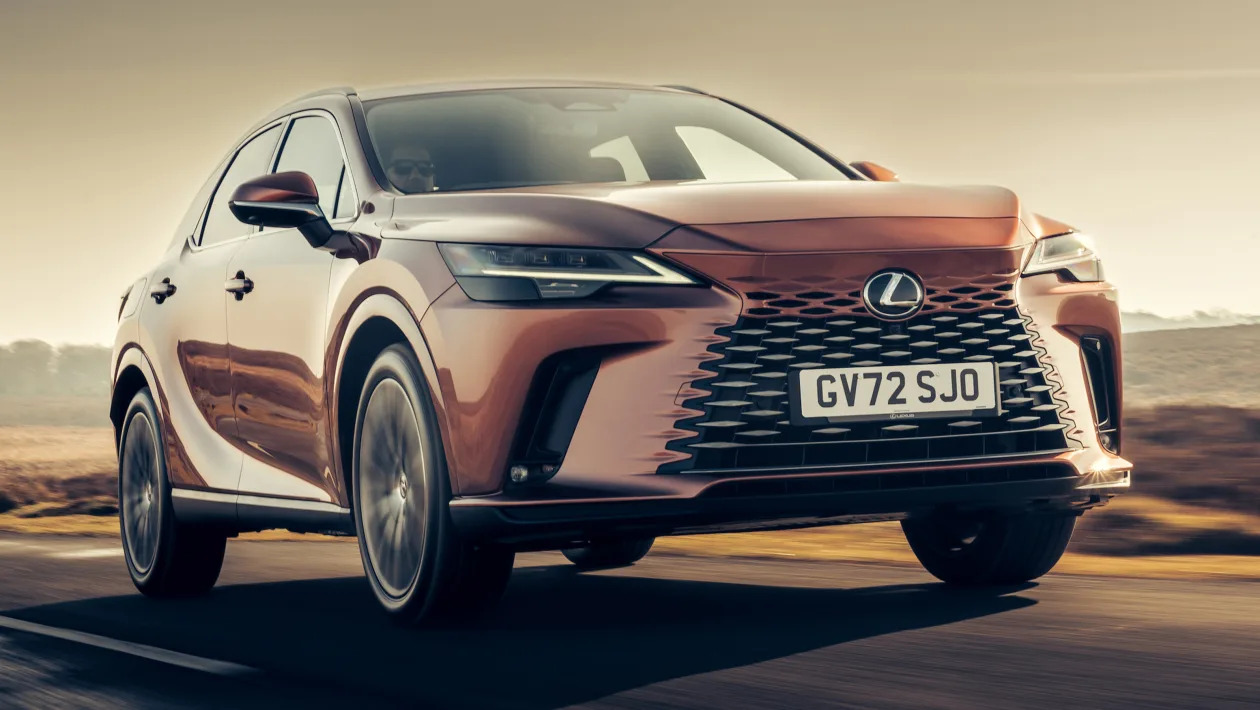
In the middle of the pack sits the 450h+, which borrows its 2.5-litre four-cylinder petrol engine and plug-in hybrid system from the new NX - the first Lexus to offer PHEV capability. The new all-electric RZ (Lexus’s first bespoke full-EV) might look similar to the RX, but that car will use the e-TNGA platform found under the Toyota bZ4X and Subaru Solterra. The RX actually sits on the same GA-K platform as the smaller NX.
Our first taste of the new RX comes in 450h+ form - which Lexus says will account for 55 per cent of sales for its large SUV. The petrol engine combines with a 18.1kWh battery and an electric motor to drive the front wheels but there’s a second electric motor on the rear axle delivering electric four-wheel drive in certain circumstances. On paper the 450h+ sounds potent enough with 304bhp allowing for a 6.5-second 0-62mph time.
It takes a little time to adapt to this powertrain and ensure you’re playing to its strengths. It uses an e-CVT gearbox so if you’re mashing the throttle for an overtake, the petrol engine’s revs will rise to a rather unrefined drone. Hard acceleration overall feels a little underwhelming in the 450h+ although the system is perfectly smooth in its power delivery. Strangely, there are gearshift paddles behind the wheel which display the CVT’s ‘gears’. Given that there’s only one variable gear available in a CVT, moving up and down the simulated steps yourself doesn’t really have much of an effect on the driving experience. You just alter the level of engine braking slightly by raising or lowering the revs, we expect 99 per cent of RX owners won’t ever use the paddles.
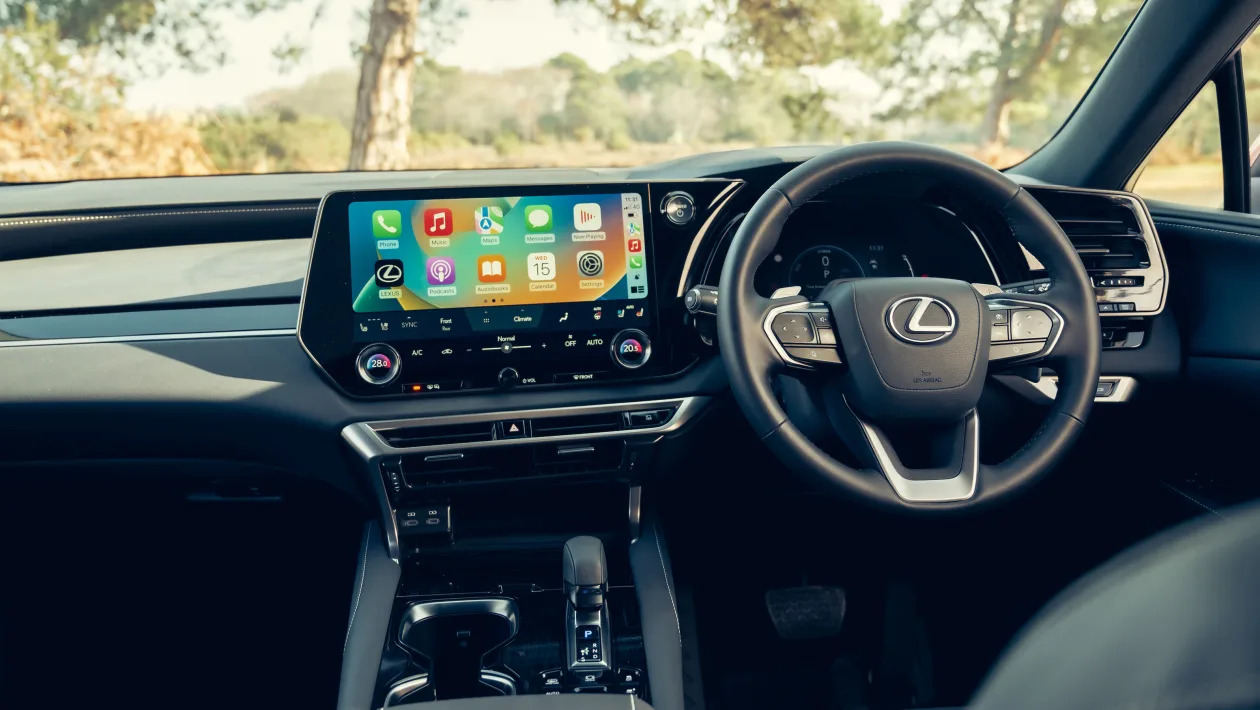
Provided you have enough energy in the battery, you can, of course, switch to electric only mode. The instantaneous torque gives the RX some extra pep around town and silent EV running certainly suits the RX’s calm persona. Lexus claims around 40 miles of electric-only running is possible - most people should get near to this figure with careful driving.
Once that 18.1kWh battery has been emptied (the 6.6kW on-board charger means a full charge takes around two hours and 45 minutes), there’s a second battery that allows the 450h+ to run as a self-charging hybrid. This essentially means you’re always utilising the efficiency benefits of hybrid running. It’s the first time we’ve come across this technology and for PHEV users that might forget to charge or find it impractical to do so regularly, it’s a nice safety net to have. Even with this innovation, the claimed 256.8mpg WLTP fuel economy figure will probably be out of reach for normal driving.
The powertrain rewards relaxed driving and this statement applies to the suspension too. Our car was fitted with adaptive damping, which doesn’t vary too much depending on your chosen setting. Even with 21-inch alloy wheels, it's plainly obvious the RX has been engineered to float over bumps and dips, rather than communicate the road surface to the driver.
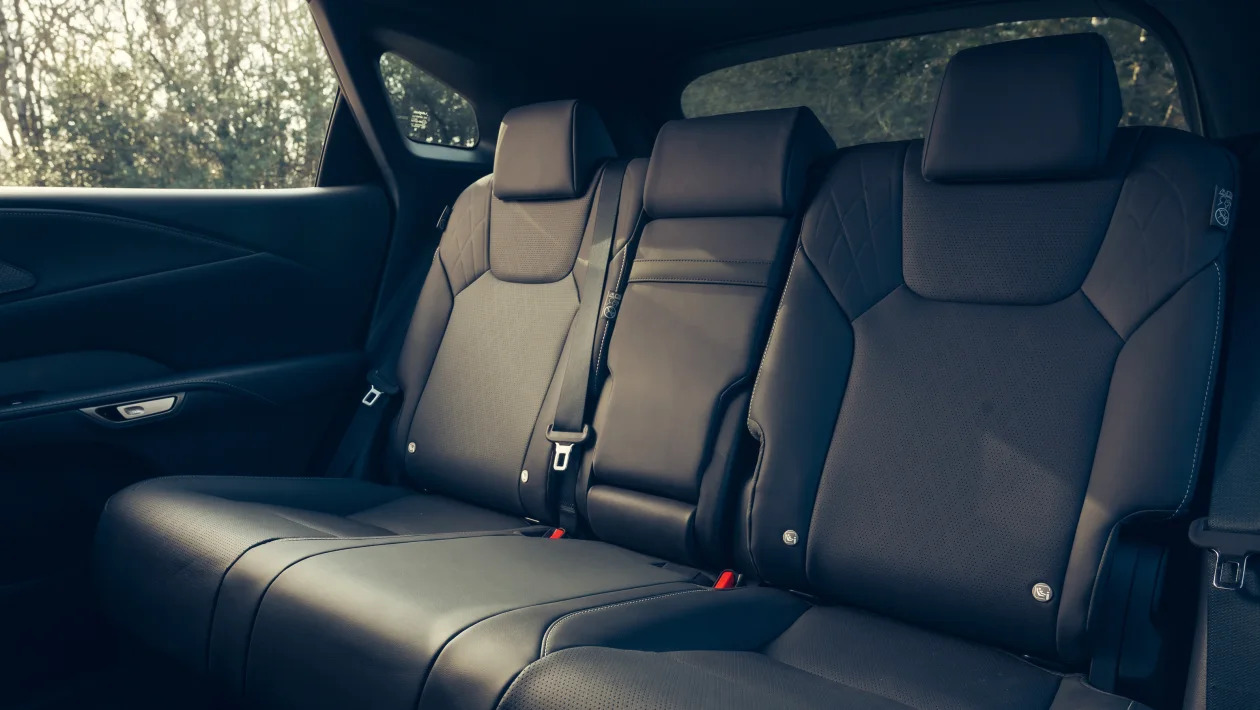
We’re keen to try out the ‘Direct4’ four-wheel drive system exclusively offered on the RX 500h, which apparently keeps pitching under acceleration and braking at bay - that rocking motion was especially prevalent on this 450h+.
Arrive at a series of bends and despite the focus on comfort, the RX can get into a rhythm. The steering wheel has a reassuring weight to it and the handling is tightened by the availability of six degrees of rear-axle steering. You’re always aware of the 2,240kg kerb weight but you can still flow the RX into corners nicely. Get a little too abrupt with steering inputs and you’ll a tendency towards safe, nose-heavy understeer.
Lexus says it has worked hard on improving the RX’s refinement, although the previous model was one of the best in its class in this respect. The powertrain certainly helps, but thicker glass and more sound proofing means this model is supremely quiet even at motorway speeds.
The interior compliments the sedate nature of the RX very well. We tested the top-spec Takumi trim level, which has a huge electric panoramic roof, heated seats front and rear, three-zone climate control and an uprated sound system.
The 14-inch central screen is the main focal point up front and the infotainment system responds immediately to inputs, either from the touchscreen itself or from the steering wheel buttons. It marks a huge step forward from the old track pad setup from the previous Lexus RX and Apple CarPlay or Android Auto can be wirelessly connected as well.
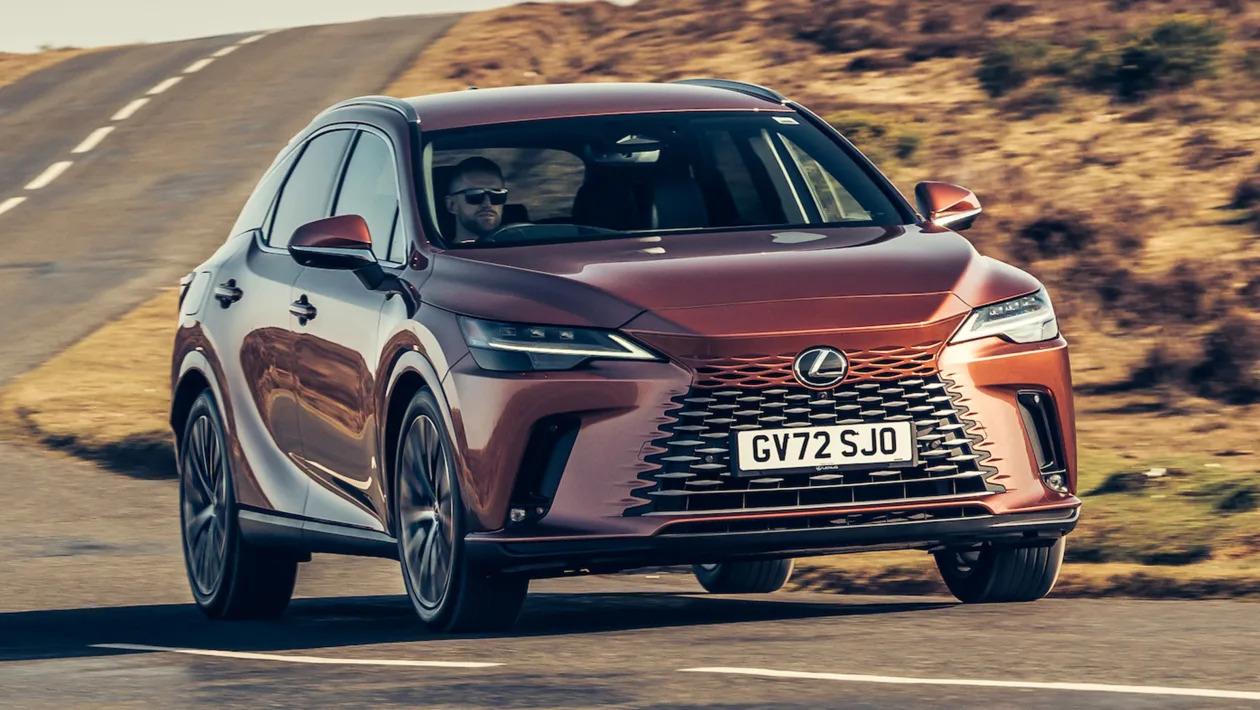
A Mercedes GLE might have the RX beaten in terms of interior wow factor, but the Lexus is up there with the very best for build quality. All the main touchpoints feel solid and things like the door handles and centre console openings are superbly damped. The rear seats can be folded up and down with the touch of a button - parents might prefer the quicker manual lever on lower-spec models.
There are lots of little cubby holes dotted around the cabin and the rear seats will accommodate three adults with no problem, but the lack of a seven-seat model is a bit of a shame. The 461-litre boot is also a little disappointing compared to the competition.
A mid-range ‘Premium Plus Pack’ still offers the panoramic roof as well as a head-up display and wireless charger. It also has the adjustable digital rear view mirror/monitor, which is an impressive bit of kit but slightly superfluous considering rear visibility is perfectly acceptable.
The RX with this 450h+ powertrain kicks off at £64,950 in Premium Plus guise - rising to £79,450 for this Takumi model. Given the new 2023 X5 starts from £66,230 with a mild-hybrid engine and you can’t get a Mercedes GLE for under £77,890, the RX 450h+ appears to be keenly priced.
2023 Ford Bronco Sport Heritage Editions Play the Retro Card
With or without its wayback garb, this baby Bronco remains impressively capable.
Ford continues to channel the rich history of its iconic Bronco 4x4 with the introduction of two new retro-inspired special editions of its compact Bronco Sport SUV.
The 2023 Bronco Sport Heritage Edition and Bronco Sport Heritage Limited Edition celebrate the birth of the Bronco brand with a classic-themed appearance package that takes styling cues from the original 1966 truck. Both variants feature a white roof, white rear badging, white 17-inch aluminum wheels, and a white grille with red BRONCO lettering.
The Bronco Sport Heritage Edition, built on the Big Bend trim level, utilizes Ford's 181-hp turbocharged 1.5-liter inline-three, which is paired with an eight-speed automatic transmission and all-wheel drive. Suspension features include hydraulic front bump stops and specially tuned springs included in Ford’s High-Performance Off-Road Stability Suspension (HOSS) system package, plus five user-selectable "G.O.A.T." terrain modes for off-road driving.
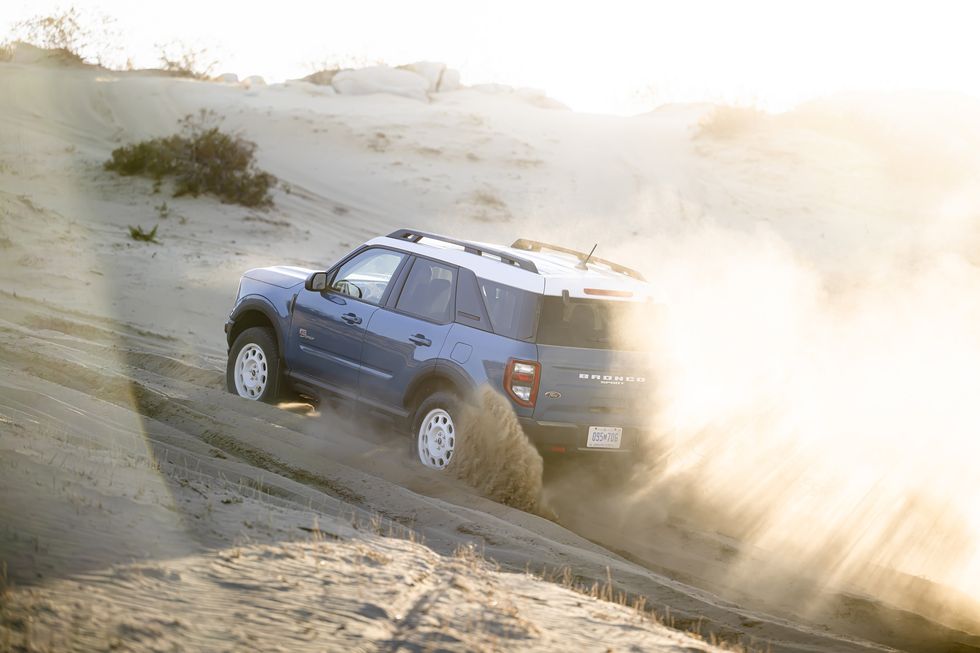
The Heritage Edition's interior styling includes white trim accents, plaid cloth seats, blue-and-red accent stitching, a microsuede center console armrest, and Navy Pier Blue accents on the door panels and dash. Buyers have a choice of seven paint options, including Robin's Egg Blue, a throwback color based on one that was available on the original Bronco.
The pricier Heritage Limited Edition is derived from the Bronco Sport lineup's more off-road-focused Badlands package, which features the larger turbocharged 2.0-liter inline-four, two additional G.O.A.T. modes, a torque-vectoring rear differential, and a lockable center clutch pack for the all-wheel-drive system. Our Peak Blue sample is one of three paint shades available, the others being the lighter Robin's Egg Blue and the intense Yellowstone Metallic.
Heritage Limited Edition–specific features include larger 29-inch all-terrain tires, leather-trimmed seats, and white door inserts. A retro-style plaque adorns the center console, while metal Bronco door badging in the classic '60s script is satisfyingly eye-catching.
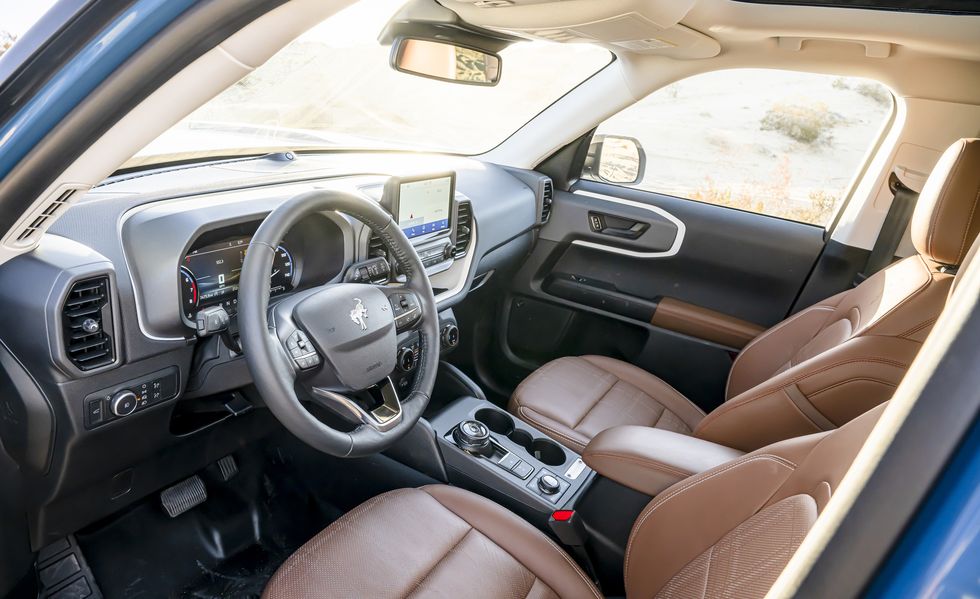
Despite its basis in the humble C2 unibody platform as used in the Escape SUV and Maverick pickup, the Bronco Sport proves to be unexpectedly capable off-road, with the 2.0-liter's 250 horsepower and 277 pound-feet of torque making light work of the steep gullies, embedded boulders, and deep sand that constitute the Johnson Valley area of the Mojave Desert. (So much of the model's off-road development was conducted here that Ford chose to include a geographic coordinate from the area as an Easter egg hidden in the molding of the rear hatch trim.)
An aluminum skid plate, part of the standard Badlands equipment package, eases concerns of stabbing the Bronco Sport's underbody with spiky terrain elements. Despite the Sport's modest ride height, its 8.8-inch ground clearance (on 235/65R-17 tires, the model's largest available) proves to be perfectly adequate for comfortably brisk-paced desert driving as we follow the dusty wake of our guide, Melissa. She is well-versed in the Bronco Sport's abilities, having taken a stock Bronco Sport Badlands to first place in the 1500-mile, off-road Rebelle Rally in both 2021 and 2022.
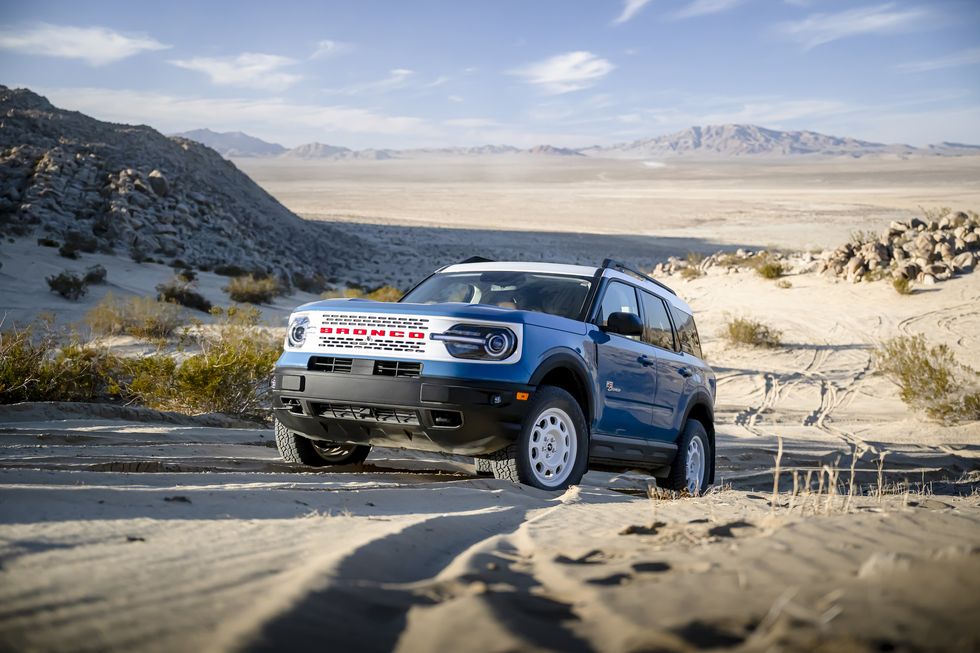
It is the suspension that makes the Bronco Sport, and despite the plethora of off-road driving modes available, this SUV handles even soft trail running just fine in its standard drive mode. Locking in the all-wheel-drive system and the rear differential is more than sufficient for confident thrashing in deeper sand.
All of that would be equally true for the less retro-tastic Badlands model, however. At $46,250, the Heritage Limited Edition is fully kitted out, carrying nearly $5000 worth of features that are optional on the Badlands. Screen that out, and you see that the retro look carries a roughly $2000 premium. One rung down, the $34,245 Heritage Edition represents a roughly $1500 upcharge over the equivalent Big Bend model.
Is that worth it? Well, several miles east of where we drove this Bronco Sport, classic Broncos, stock and modified, are swarming the viewing areas of this year’s King of the Hammers desert road-race competition. For off-road enthusiasts, the appeal of those classic Broncos, the reborn Bronco, and this offshoot Bronco Sport is wrapped up in the combination of capability and aesthetics. The Bronco Sport Heritage Editions lean more heavily on the latter, but to no detriment of the former.
2023 Mitsubishi Outlander Sport
The Outlander Sport is not for those who want the latest technology or for those whose passion is driving. Instead, it's for getting passengers and cargo from point A to point B. Its climate and radio controls are easy to use, and having selectable all-wheel drive helps those who live in less temperate climates.
Pros
Well equipped for the price
Excellent warranty coverage
Cons
The ride is rough over bumpy roads
Many interior materials look and feel cheap
Transmission is aggravatingly slow to respond
Raucous drone while accelerating, especially with 2.0-liter engine
What's new
All-wheel drive is now standard across the board
Special Edition trims no longer available
Part of the first Outlander Sport generation introduced in 2011
The 2023 Mitsubishi Outlander Sport is the least expensive SUV in the Japanese automaker's lineup and also one of the oldest vehicle designs currently on sale. The Outlander Sport was introduced in 2011 and has undergone many exterior face-lifts in the intervening years. The styling tweaks help the small crossover look more like a modern offering, but there's only so much you can do to mask the Outlander Sport's aging architecture.
For its 12th year on the market, the Outlander Sport receives standard all-wheel drive across the lineup. Other than that, changes are minimal for 2023. The small SUV continues to offer the same blend of value, practicality and acceptable driving dynamics. We recommend checking out its competitors, the Honda CR-V, Mazda CX-50, Subaru Forester and Hyundai Tucson, before going with the Mitsubishi. But if you just need basic transportation from point A to B with a good warranty, the Outlander Sport might fit the bill. Read our Expert Rating below to get all the details on it.
6.1/10
Edmunds Rating
Our VerdictThe Edmunds Vehicle Testing Team evaluates a fresh batch of vehicles every week, pairing objective assessments at our test track with real-world driving on city streets, freeways and winding roads. The data we gather results in our Expert Ratings. They’re based on 30-plus scores that cover every aspect of the automotive experience.
The Outlander Sport is not for those who want the latest technology or for those whose passion is driving. Instead, it's for getting passengers and cargo from point A to point B. Its climate and radio controls are easy to use, and having selectable all-wheel drive helps those who live in less temperate climates.
Rated for you by America's best test team.
Performance 5.0/10
How does the Outlander Sport drive? The "Sport" in Outlander Sport is a misnomer. The engine is underpowered, the continuously variable automatic transmission performs poorly, and handling and suspension tuning are unrefined. It's a pretty dreary vehicle to drive. Acceleration is jumpy from a stop but settles into a 8.5-second crawl to 60 mph. Under heavy braking, we noted both extreme nosedive and side-to-side wiggle, neither of which instills confidence.
There's very little on-center steering feel, so you must constantly tend to the Outlander Sport's steering, and inputs are met with a delayed reaction from the SUV. Stiff shocks make the Outlander Sport skittish, especially around bumpy corners, yet do nothing to tame the large amounts of body roll.
Comfort 5.0/10
How comfortable is the Outlander Sport? The Outlander Sport lacks the ride comfort and suspension compliance of its competition. For a vehicle that has been on the market for as long as this Mitsu has, there's really no excuse for this. It's OK for around-town use, but long-distance drivers should look elsewhere.
The ride is particularly egregious: harsh over bumps yet floaty over smoother undulations, giving you the worst of both worlds. The leather-upholstered seats in our test vehicle were hard and inflexible, and the cabin was noisy from traffic, road surfaces and the loud climate control fans.
Interior 6.0/10
How’s the interior? If you're the right size, the Outlander Sport's ergonomics are appealing. This SUV is easy to operate, with clearly marked controls and an easy-to-read instrument panel. The large door openings allow easy access to the front seats. Rear passengers will have to duck a bit to maneuver into the seats. Overall, interior space is lacking, with less rear headroom than some competitors and an interior that feels tight from every seat.
Compounding the lack of roominess, the driver's seating position is not particularly adjustable, forcing you into a sit-up-at-the-dinner-table posture. Visibility is also lacking, with large roof pillars and a small rear window that limits your view out of the back.
Technology 6.5/10
How’s the tech? Don't come here if you're looking to get your connectivity or mobile technology fix. What the Outlander Sport provides is basic connectivity. One upshot of the simple infotainment system is that it's very easy to learn to use. Apple CarPlay and Android Auto aren't standard on the base model, but the standard Bluetooth connectivity is simple to set up.
Basic active safety features such as automatic emergency braking are not standard and only appear on the midrange SE trim or higher. There's no adaptive cruise control at any trim level.
Storage 6.5/10
How’s the storage? The Outlander Sport doesn't excel in any area but works acceptably for cargo duty. The 60/40-split rear bench seat can be folded without removing the headrests or sliding the seats forward, but the release button is difficult to access from the cargo area. Once folded, the load floor is flat and expansive, and the tall roofline makes loading easy.
There's an average amount of small-item storage inside the Outlander Sport. The door pockets are large and can accommodate a medium-size water bottle, and the cubby under the center stack can hold a phone. There are two cupholders and a cubby situated in the center console. Car seats can be accommodated in the two outboard rear seating positions thanks to easily accessible lower hooks, while the upper hooks can only be accessed from the cargo area.
Fuel Economy 6.0/10
How’s the fuel economy? The Outlander Sport GT is rated to get 25 mpg in combined driving (23 city/28 highway). We saw an average of 22.7 mpg over the course of three fill-ups while driving on city, highway and mountain roads. While on the low side, this type of result is expected for an underpowered vehicle.
Value 8.0/10
Is the Outlander Sport a good value? For those who value cost above all else, the Outlander Sport offers the basics as a compact SUV. We could easily recommend any number of other models, but they would all cost more. Our test vehicle came in a few thousand dollars under direct competitors. But you may be willing to spend more to get better performance, additional connectivity features and driver assists that are simply not available on the Outlander Sport.
The Outlander Sport's design is dated, but it feels sturdily assembled even if the quality of materials is subpar. On the plus side, Mitsubishi offers a very strong warranty and a roadside assistance program similar to those found on premium vehicles. That peace of mind certainly adds to the Outlander Sport's value proposition.
Wildcard 6.010
A jack-of-all-trades but a master of none, the Outlander Sport is purely a machine for transportation. Any sort of fun or enjoyment will come from the overactive imagination of the driver. As an easily approachable, no-nonsense car, the Outlander Sport appeals to those who prioritize a low price above any kind of driving satisfaction. It's not the most charismatic car you'll meet on the road, but thanks to its warranty and roadside assistance, it is dependable.
Which Outlander Sport does Edmunds recommend?
It might be tempting to get the cheapest Outlander Sport available, but we think the midtier LE trim hits the sweet spot and is worth spending a few thousand more for. That model gets you a tech upgrade with a larger 8-inch touchscreen and Apple CarPlay and Android Auto smartphone integration. You'll also enjoy extra creature comforts like a leather-wrapped steering wheel and heated front seats.
Mitsubishi Outlander Sport models
The 2023 Mitsubishi Outlander Sport is available in five trim levels: S, ES, LE, SE and GT. All but the GT are powered by a 2.0-liter four-cylinder engine (148 horsepower, 145 lb-ft of torque). The GT receives a more powerful 2.4-liter four-cylinder engine (168 hp, 167 lb-ft). Both engines come paired with a continuously variable transmission (CVT) and all-wheel drive is standard on all models.
S
The base S model comes impressively equipped. Highlights include:
16-inch wheels
LED headlights
Automatic high beams
Heated, power exterior mirrors
Automatic wipers
Height-adjustable driver's seat
60/40-split folding rear seats
Automatic climate control
7-inch touchscreen
Drive mode selector
Four-speaker audio system
Single USB port
Auto-dimming rearview mirror
These driver aids are standard on all trim levels:
Forward collision mitigation (warns you of an impending collision and applies the brakes in certain scenarios)
Lane departure warning (alerts you if the vehicle begins to drift out of its lane)
Automatic high-beam assist
ES
The ES adds:
18-inch alloy wheels
LED foglights
LE
Stepping up to the LE trim adds:
Leather-wrapped steering wheel
8-inch touchscreen
Apple CarPlay and Android Auto smartphone integration
Heated front seats with contrast stitching
Additional front and rear USB ports
Voice recognition controls
SE
Moving up to the SE trim adds:
Power-folding mirrors
Hands-free keyless entry and push-button ignition
Six-speaker audio system
Blind-spot warning with rear cross-traffic warning (alerts you if a vehicle is in your blind spot during a lane change or while reversing)
GT
Besides the more powerful engine, the range-topping GT model gets you:
Black roof rails
Leather upholstery
Black headliner
Power-adjustable driver's seat
2023 Jeep Grand Cherokee 4xe PHEV Costs a Lot to Save a Little
Faithful at-home charging can keep the plug-in-hybrid Grand Cherokee away from the gas pumps, but bringing one home won't be cheap.
Hearing the Jeep Grand Cherokee 4xe described as the "most fuel-efficient Jeep ever" gives us the warm fuzzies. It feels like a win for the world and makes us want to parade through an aisle at Whole Foods, high-fiving every farm-to-fork enthusiast until our palms turn red. But while the 4xe's EPA-estimated 56 MPGe and 26 miles of electric-only range are good for a Grand Cherokee, the plug-in-hybrid option is an expensive one.
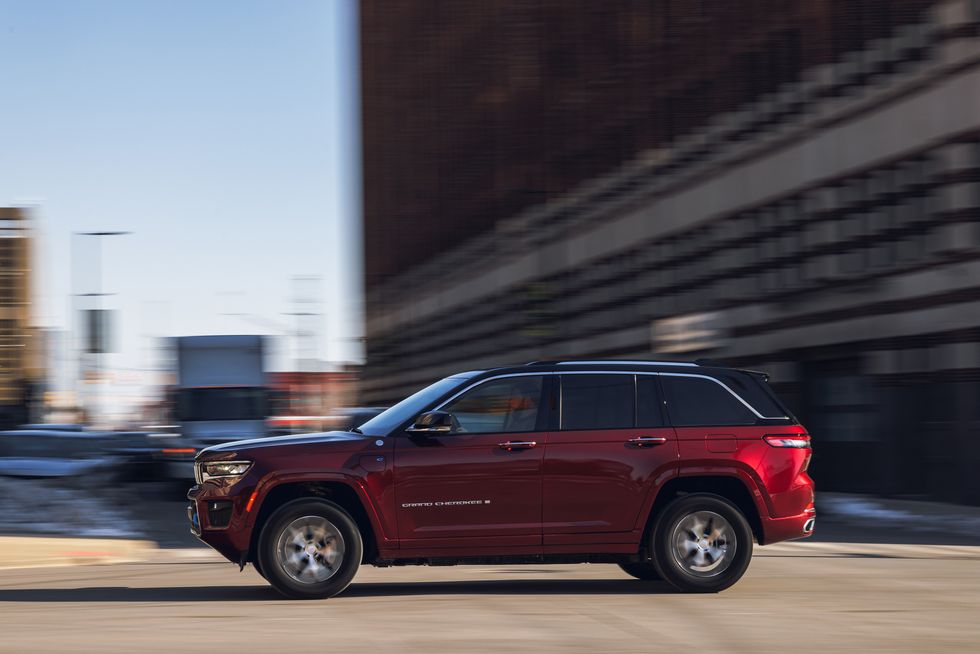
That's not to downplay the effort by Jeep to reduce its wonderfully luxurious SUV's usage of gasoline. The Grand Cherokee, which was redesigned last year, is an absolute honey on the road. With a firm brake pedal, linear steering, and a smooth ride, the Grand Cherokee moves with confidence. Its lavish interior and robust four-wheel-drive system make it akin to a Kia Telluride that's graduated from off-road boot camp. Unlike its Wrangler 4xe plug-in-hybrid sibling, the Grand Cherokee 4xe is subdued and quiet at speed. At idle, however, a grumpy 46 decibels from the inline-four echo throughout the cabin.
A 270-hp turbo 2.0-liter and two electric motors bring the total output to 375 horsepower and 470 pound-feet of torque, a combination potent enough to make passengers ask, "This is a four-cylinder?" (which, really, is the best compliment a four-cylinder can hope for). We noticed some hesitation when accelerating hard from low speed as the gas engine and electric motor bickered over whose turn it was.
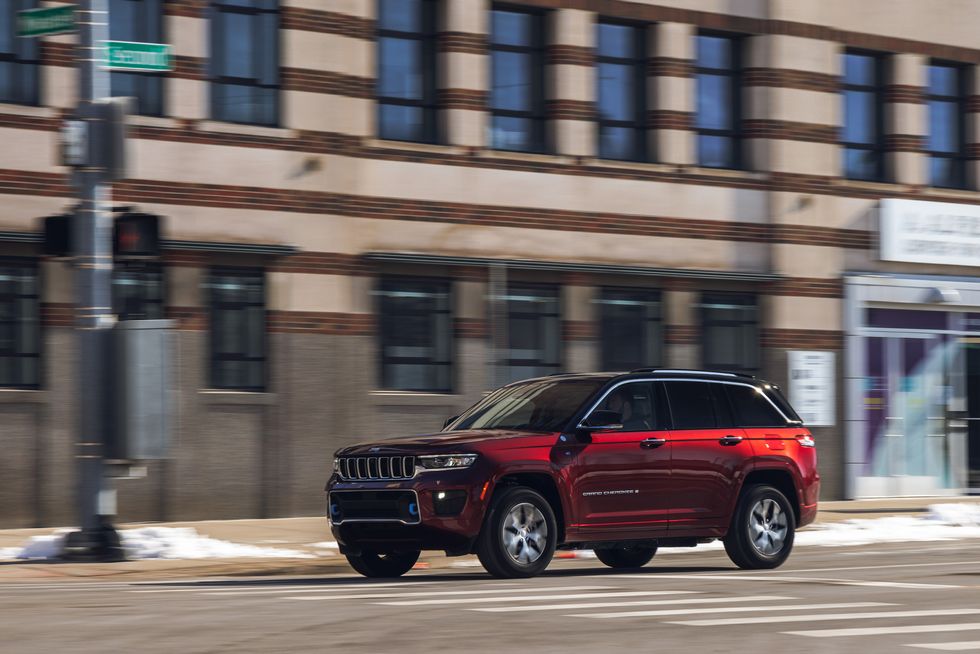
In the Wrangler, we noted this powertrain's rocky transitions between gas and electric propulsion, although they were somewhat lost amid the Wrangler's general cacophony. In the vastly more polished Grand Cherokee, the powertrain's hesitation and its abrupt transitions stand out.
Eventually, the powertrain suffered a more serious fault, and the hybrid system went silent. As a result, we were unable to record an as-tested fuel economy, nor can we provide you with the 4xe's 75-mph highway fuel-economy results.
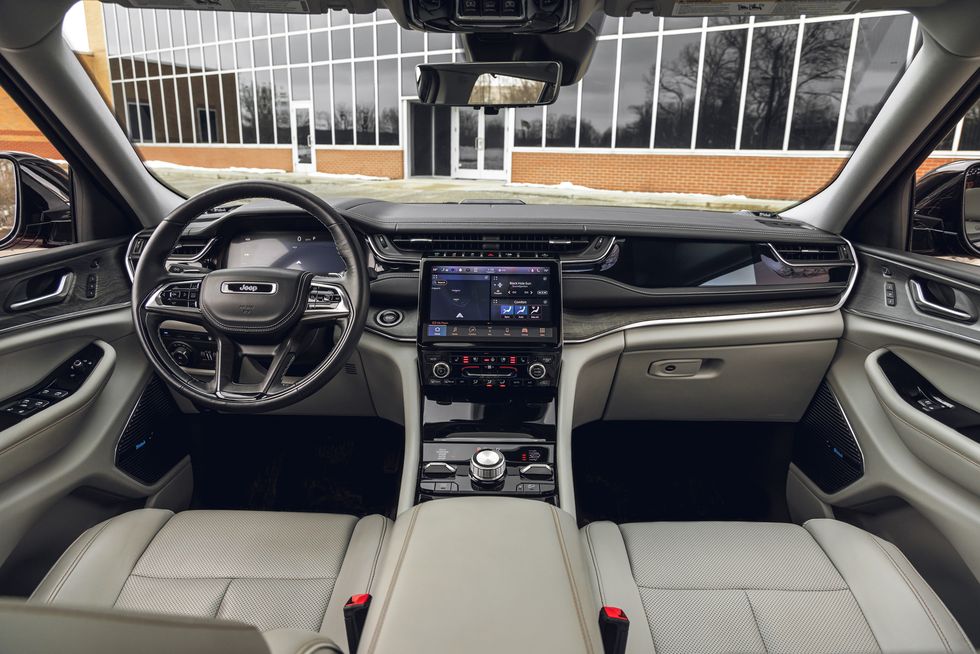
We were able to perform instrumented testing before the hybrid-system failure and found that the 4xe is the quickest version of the new Grand Cherokee. It springs to 60 mph in 5.3 seconds and hits 100 mph in 13.9 seconds, right as it reaches a quarter-mile. That's 0.3 second quicker to 60 mph and 1.3 seconds sooner to 100 than the discontinued V-8 version. When it comes to lugging, the 4xe's 6000-pound maximum towing capacity is 200 pounds short of the V-6 and 1200 less than the dead V-8 model.
The Grand Cherokee 4xe starts at $61,660, which is $16,830 more than the base four-wheel-drive V-6 Laredo. The 4xe, though, skips the Laredo trim and is available only in Limited, Trailhawk, Overland, Summit, and Summit Reserve grades. Comparing like trims, the 4xe's upcharge over the V-6 variants with four-wheel drive ranges from $8685 to $10,010—although that can be at least partially offset by the PHEV's $7500 federal tax credit.
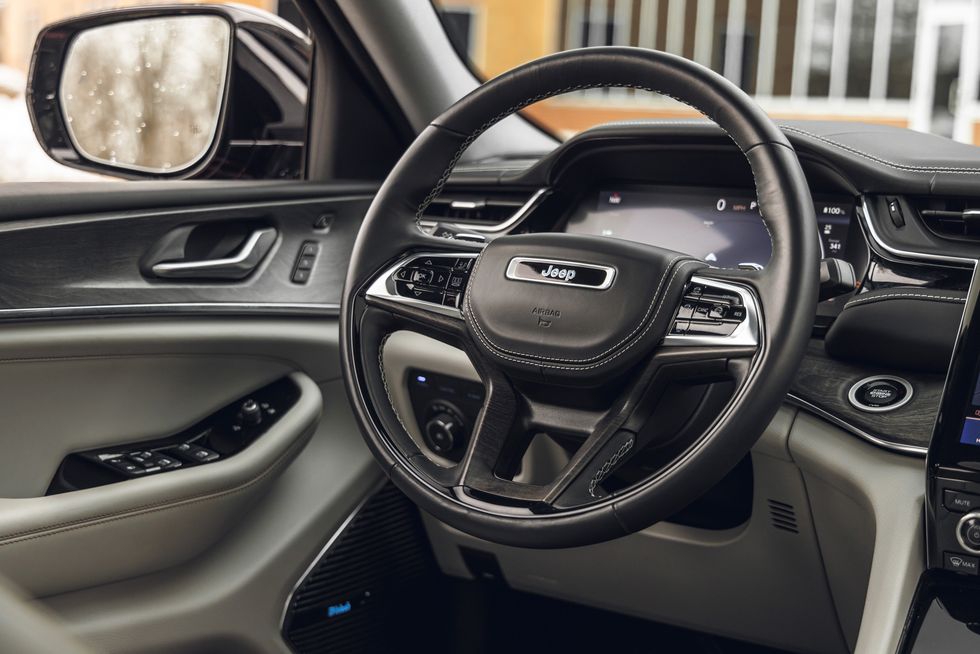
Our Overland test rig rumbled in with a $77,525 price tag. The two largest contributions to its bill were optional packages. A Luxury Tech Group IV ($2155) included nappa leather seats with a massaging front row, wireless device charging, and window shades for the back seats. An Advanced Protech Group III ($2235) added head-up display, night vision, and additional driver-assistance features.
This higher-trim model also had the available 10.3-inch front passenger interactive display screen. Taking the opportunity to nerd out, we connected Valve's Steam Deck handheld gaming PC via an HDMI cable while waiting for a takeout order. Although playing the video game SnowRunner in a snowy parking lot sounds ironic and fun, we found the screen to be incredibly dim, even at night with the brightness fully cranked.
Owners with short commutes may be able to avoid gas stations for months, bouncing between the workplace and home, where a typical 240-volt charging connection to the 4xe's 7.2-kW onboard charger can juice up the roughly 14.0-kWh battery in about 2.5 hours. For folks plugging into a standard wall socket, the charge could take eight to 15 hours, depending on the home’s outlet. However, footing the bill for the pricey Grand Cherokee 4xe just to avoid gas stations seems like an overpriced convenience.
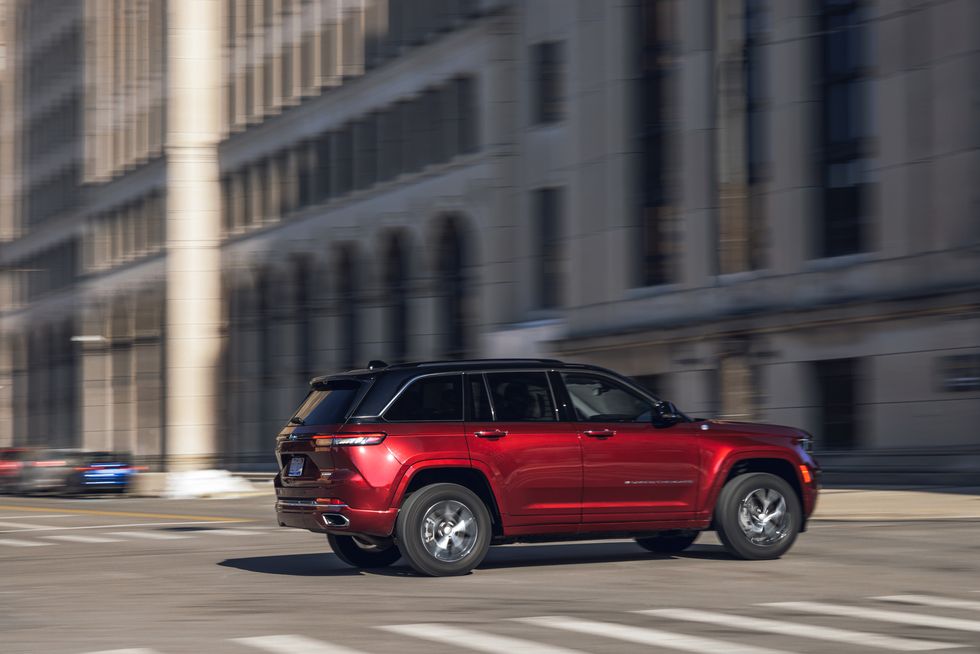
Specifications
2023 Jeep Grand Cherokee 4xe
Vehicle Type: front-engine, front-motor, 4-wheel-drive, 5-passenger, 4-door wagon
PRICE
Base/As Tested: $61,660/$77,525
Options: Overland trim (air springs, front tow hooks, hands-free liftgate, LED headlights, backlit door handles, heated and power folding exterior mirrors, 20-inch wheels, automatic wipers, ambient interior lighting, auto dimming rearview mirror power tilt/telescoping steering column, power-folding second row rear seats, McIntosh stereo, front-parking assist), $8015; Advanced Protech Group III (head-up display, night vision, surround-view camera, off-road camera), $2235; Luxury Tech Group IV (nappa leather seats, digital rearview mirror display, wireless device charging, massaging front seats, four-zone climate control), $2155; front passenger interactive display, $1095; Off-Road Group, (Goodyear All-Terrain tires, electronically controlled limited slip rear differential, underbody skid plates), $1095; black-painted roof, $775; Velvet Red Pearlcoat paint, $495
POWERTRAIN
turbocharged and intercooled DOHC 16-valve 2.0-liter inline-4, 270 hp, 295 lb-ft + 2 AC motors, 44 and 134 hp, 39 and 195 lb-ft (combined output: 375 hp, 470 lb-ft; 14.0-kWh lithium-ion battery pack (C/D est); 7.2-kW onboard charger)
Transmission: 8-speed automatic
CHASSIS
Suspension, F/R: multilink/multilink
Brakes, F/R: 13.9-in vented disc/13.8-in vented disc
Tires: Goodyear Wrangler All Terrain Adventure
265/60R-18 110T M+S
DIMENSIONS
Wheelbase: 116.7 in
Length: 193.5 in
Width: 77.5 in
Height: 70.9 in
Passenger Volume, F/R: 56/51 ft3
Cargo Volume, F/R: 71/38 ft3
Curb Weight: 5664 lb
C/D TEST RESULTS
60 mph: 5.3 sec
1/4-Mile: 13.9 sec @ 100 mph
Results above omit 1-ft rollout of 0.3 sec.
Rolling Start, 5–60 mph: 6.1 sec
Top Gear, 30–50 mph: 3.4 sec
Top Gear, 50–70 mph: 4.3 sec
Top Speed (gov ltd): 117 mph
Braking, 70–0 mph: 189 ft
Roadholding, 300-ft Skidpad: 0.79 g
EPA FUEL ECONOMY
Combined/City/Highway: 23/23/24 mpg
Combined Gasoline + Electricity: 56 MPGe
EV Range: 26 mi
Source: caranddriver.com

